The Greek city of Edessa. Edessa - “the city on the water
Edessa (translated from the Phrygian dialect means a fortress on the water) - small town in the north of Greece. It was founded over 3000 years ago. The Greeks immediately associate it with waterfalls. Many people call Edessa the "Water City", which is not far from the truth, because Edessa can easily be called "the city of eternal moisture". It attracts thousands of tourists with its picturesque waterfalls and extraordinary beautiful parks... The city is solid, patriarchal, “noble and worthy,” as the Roman historian Titus Livy called Edessa.
In Edessa, everything is permeated with music ... the music of water and stone. Walking along the streets of the city of Edessa, dotted with many water channels, you will hear the incessant murmur. Listen, this is not the sound of water. Naiads (river nymphs, local mistresses) whisper to each other about the suffering of lovers. They carry torment and agony to the edge of the captivating waterfall of Edessa, where they throw them down, breaking them against a stone. There, the water picks them up with foam and carries them away. Immediately the nymphs boast in front of Iris (the goddess of the rainbow) of their help to their beloved. And if mere mortals are not allowed to contemplate the nymphs and gods, then you can always see the rays from the iridescent wings of Iris (rainbow) on a sunny day. With a golden bowl filled with sacred water from the Styx River and the oaths of the gods, she often comes to the waterslide in Edessa to chat with the Naiads in the light of the splashes in the sun.
One of the versions of the formation of the Edesian waterfalls is reported in the Russian chronicle. According to its author, in 1395 there was a catastrophic earthquake that caused the appearance of large and small waterfalls. Scientists also concluded that until the end of the XIV century Edessa could not boast of its water potential: the bulk of the water was collected in a small depression in the west of the city. And then something happened! The river, which skirted the settlement on the eastern side, directed its waters through the city to the cliff. It is noteworthy that Greek sources do not speak about a destructive earthquake, but only about a certain "geological" or "weather" phenomenon, which resulted in the appearance of waterfalls spectacularly falling from the rocks. This version has been supported since the travels of Chelebi and other Western travelers who visited Greece after him.
Six decades ago, Edessa was not at all considered a tourist route. Only brave men, not afraid of dangers, made their way to the waterfalls. The waterfalls owe their tourist development ... to the Germans, who in 1942, during the occupation of Greece, were the first to see the waterfalls not dangerous natural phenomenon, but a manifestation of the power of nature. So, two pools, fancy flower beds grew near the waterfalls: the place turned into a kind of resort, which after the end of the war came into the possession of the local municipality. The area around is ideally equipped - you can take a magnificent walk along the neat alleys in the shade of evergreen trees and watch the raging streams of pouring water. Previously, there were about 7 waterfalls, but now there are 2 large and many small ones, bridled by man into stone gutters.
Today the Edesa waterfalls are known all over the world. This, of course, is not Niagara, but, between us, leaving behind the waterfalls of Edessa, the traveler does not leave the fairy tale. The magic continues - in the austere and exuberant Macedonian nature. This doesn't happen with Niagara! It takes your breath away while you are in the park. When you leave it, it’s as if the screen goes out in a cinema and the lights come on. All magic disappears. Edessa is another matter! After visiting the waterfall called "Keranos", the water of which falls from a height of about 30 meters, fans of the water element are invited to visit the Water Museum, which sets an example of how old and mostly abandoned industrial facilities can be explored on a tourist basis. It is obvious that in a city with so much falling water, the work of almost all factories, plants and mills was based on the exploitation of its power. The Museum of Water and the Park of Waterfalls laid out around it are aimed at acquainting the guests of the city with the history of factory machines driven by water, with the history of the Edesa industry. At the beginning of the 20th century, there were so many factories (mainly weaving) in Edessa that the city was named Balkan Manchester!
The inhabitants of Edessa are proud of the city and are passionate about the natural and cultural heritage. In the 60s, as a result of protests and demonstrations, the government's program to pacify nature and install a hydroelectric power plant was terminated. Without this resistance, the spirit of the city of lovers would have disappeared, the wonderful waterfalls, for sure, would have left the river nymphs, the neighborhood with steel aggregates would not suit them. And numerous tourists, including those from Greece, would not be in a hurry to get acquainted with the technology of the units instead of the graceful nature.
Edessa Waterfalls (Thessaloniki, Greece) - detailed description, location, reviews, photos and videos.
- Tours to Greece for the New Year
- Last Minute Hotels in Greece
Add a review Track
Previous photo Next photo

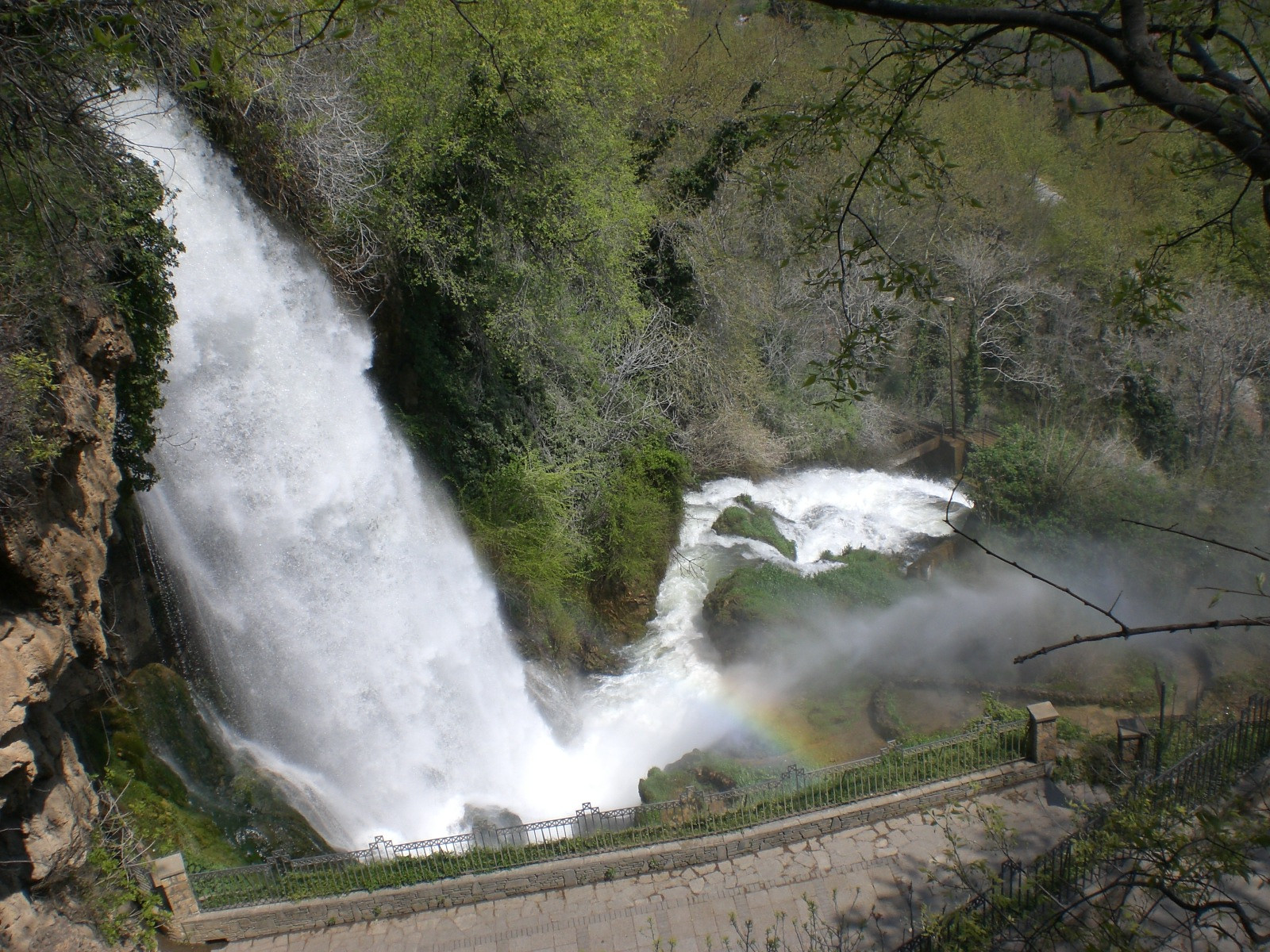
The ancient city and modern tourist center of Edessa, which is not far from Thessaloniki, is famous for its wonderful waterfalls and belongs to the richest cities in Europe and the planet in general. That is why it is sometimes called the city of waterfalls, which, moreover, are the largest in the Balkans. The locals are proud of this exceptional corner of nature and jealously protect it from any influences of modern civilization. And travelers from all over the world come here to see the abode of river nymphs and touch a piece of antiquity.
A bit of history
The appearance of waterfalls is attributed to 1395, when a strong earthquake happened in the local vicinity, which affected the structure of the relief. Then the river, passing along the eastern side of the settlement, changed its course, directing the waters straight through the streets to the cliff. This is how 7 turbulent streams appeared, rushing down from the slopes, but so far there are only 2 of them left.
Until the 1940s. these places were deserted and poorly populated. Oddly enough, the situation changed with the arrival of the German occupiers in Greece. One of the soldiers built small ponds and planted flower beds. A few decades later, a favorable climate, fertile soil and sun turned the creation of human hands into a heavenly place.
A blooming garden appeared in Edessa after the arrival of the German invaders.
What to see
The main interest is big waterfall... It is called Koranos after the first Macedonian ruler. The area around it is equipped with many viewing platforms, benches and an outlandish bridge - standing under it, you can admire the picturesque centuries-old water stream from the inside.
The imagination is struck by the lush vegetation, hundreds of flowers and several colorful buildings, and those who wish to hide from the heat will be pleased to walk along the concrete paths in the shade of trees.
Connoisseurs of water treatments will love a visit to the Lutra Pozar hydrotherapy center with a huge wellness center, massage parlors, a hammam and pools with crystal clear water.
In December, we made a short trip north to the thermal springs of Lutra Pozar. On the way there, we couldn't help but stop by to admire one of the Balkan wonders - the famous waterfalls in the city of Edessa.
Edessa is worth to devote time to her, to see the city itself and its sights.
Unfortunately, we didn't have much time, I just noticed for myself the beautiful central cathedral of the city, a square with a huge bizarre plane tree, picturesque canals with green flowing water. There are also museums, ancient clocks, temples, mosques, ruins ancient city, quarters of the old city with traditional buildings ... But the most famous attraction of Edessa is its unique waterfalls, the largest in the Balkans.
Edessa Waterfalls Greece
It is not for nothing that Edessa is called the City of Waters, because it is perhaps the only city in the world where waterfalls are located very close to the city center. The vast Park of Waterfalls covers about 100 thousand square meters and is located on the edge of a cliff, from which a total of 11 waterfalls flow down. There are two large and attractive for inspection - Kharanos and the so-called Double.
![]()
Here really is broken beautiful park where a variety of trees grow between the babbling large and small streams and canals - spruce, beeches, fanciful plane trees. There is a large cafe above the waterfalls where we enjoyed a cup of coffee to begin with.


Summer cafe terrace in winter
It is believed that the waterfalls appeared at the end of the 14th century after an earthquake or some other natural disaster. Until then, the waters were collected in a lake located west of the city, but at one fine moment the streams suddenly changed their direction and began to erupt from the sheer cliff, forming many large and small waterfalls.
The walk begins from the parking lot with a descent along the canals to the edge of the cliff, where, with the noise of a departing train, the bubbling foam of water flows breaks free.
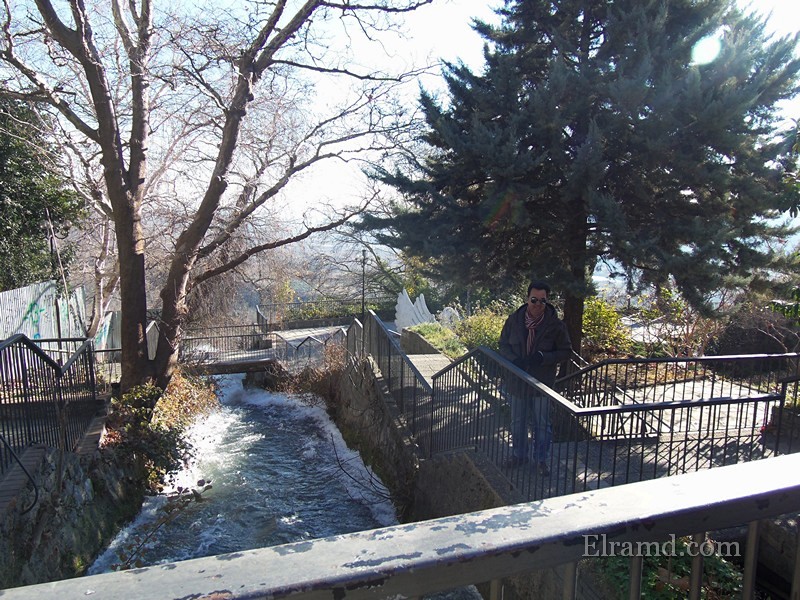
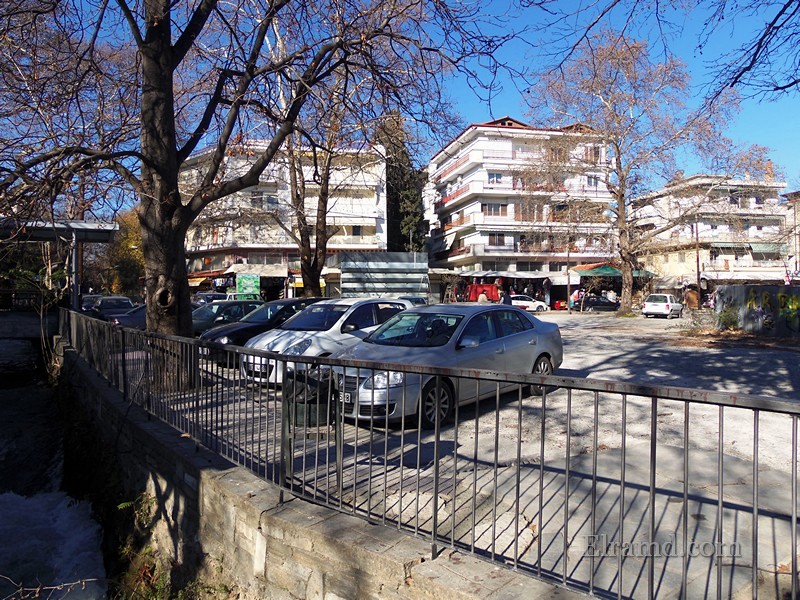

As I understand it, this is the same Double Falls, the second largest after Kharanos.
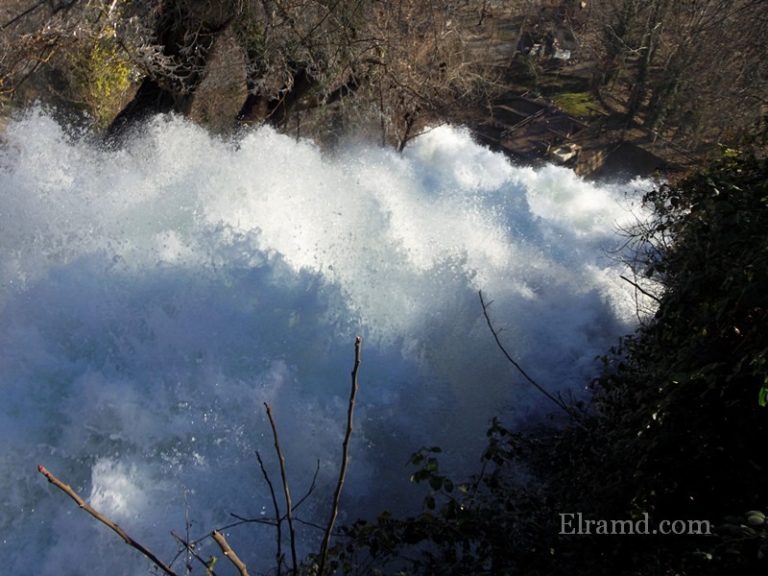
Water fills the stone swan pond that adorns the park.

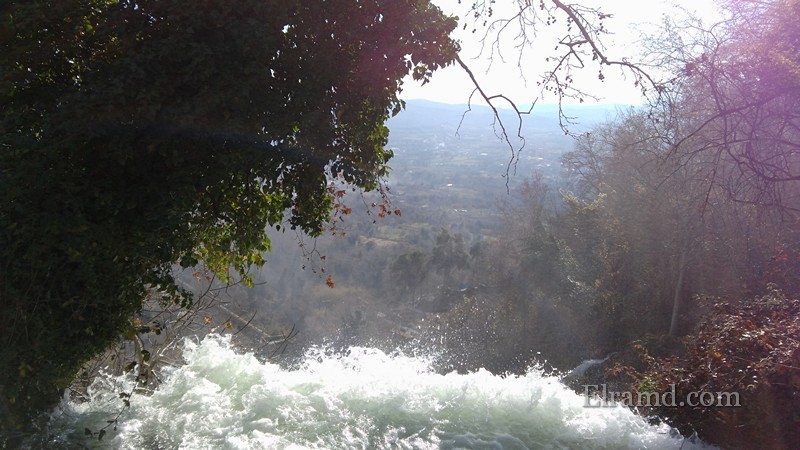
Kharanos - the largest and most beautiful waterfall
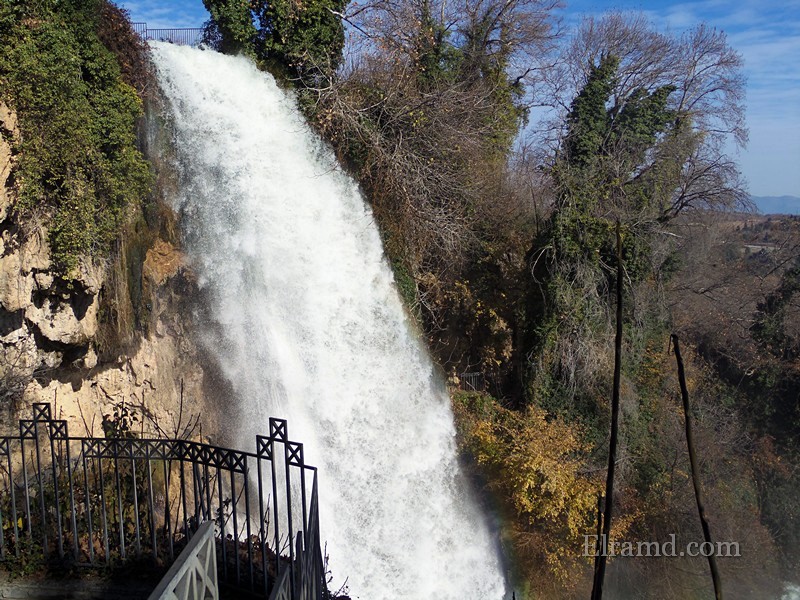
Kharanos waterfall, Edessa
Kharanos is a seventy-meter water column that falls spectacularly from a sheer cliff and scatters diamond spray in the air. Its appearance evokes quiet delight and admiration for the power and beauty of nature.

In addition, he bears the name of the very first Macedonian king that myths tell us about. Once Kharanos received the oracle's prediction that he should look for a place for a new kingdom in the vastness of Macedonia, and that he would find his kingdom where a herd of goats would lead him. Kharanos set out on a campaign with his army, and in the mountains of Edessa they met a herd of these animals, which they followed. They walked under heavy rainfall and in pitch fog, so they entered the city, unnoticed by the inhabitants, and captured it without a fight. In the future, before his army, Kharanos always let goats in the vanguard, which were supposed to bring him success and good luck.
Kharanos renamed Edessa to Eges (Αιγές, which in translation simply means "goats"), and made the city the first Macedonian capital, and called the inhabitants aegeads. Famous expression "Under the auspices" (υπό την αιγίδα) comes from here, since the aegis (αιγίδα) simply means a shield made of goatskin. So the Karanos waterfall is under the auspices of the city of Edessa.
King Kharanos expelled Midas, who ruled part of Macedonia, as well as other local rulers, and unified the whole country under his rule, laying the foundation for further development. After him Perdiccas reigned, it is he who is sometimes also called the first Macedonian king.
Now the majestic Kharanos Falls spews 5-10 cubic meters per second into the abyss, depending on the season. So that everyone can admire its power, comfortable steps are laid down, there are observation platforms with benches. From anywhere, the slightly intimidating stream of water looks great.
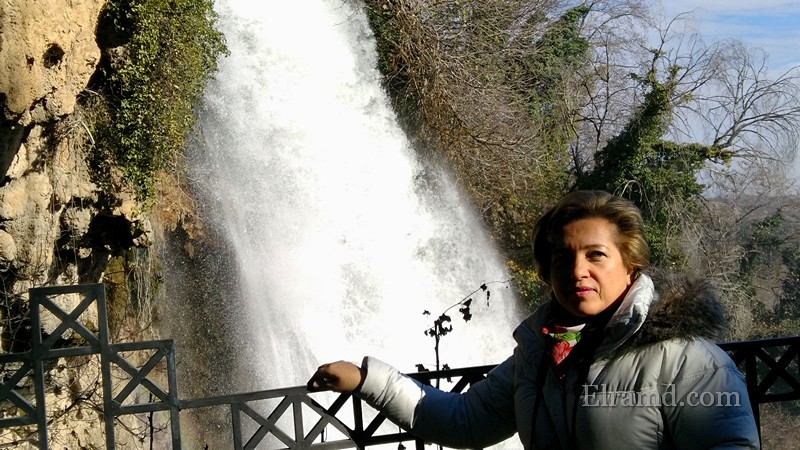
Edessa waterfalls cave
On one of the sites - the entrance to a small stalactite cave in the rock, inside the caretaker sits and accepts a visit fee - 0.50 euros per person.
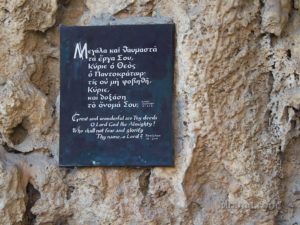
The cave is small, only a few tiny rooms, but it is interesting to look at the stalactites.
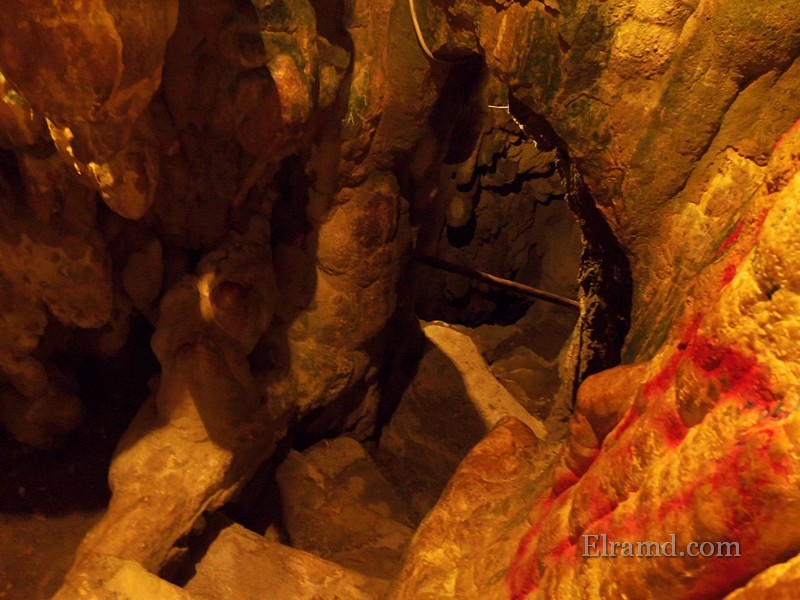
Deep in the cave
True, many of them are written approximately like "Vasya was here", only in the Greek version. The place where there are especially many such inscriptions is called the Frozen Waterfall. Judging by the fact that excursions mainly bring tourists and schoolchildren with students, it is they who leave these inscriptions.
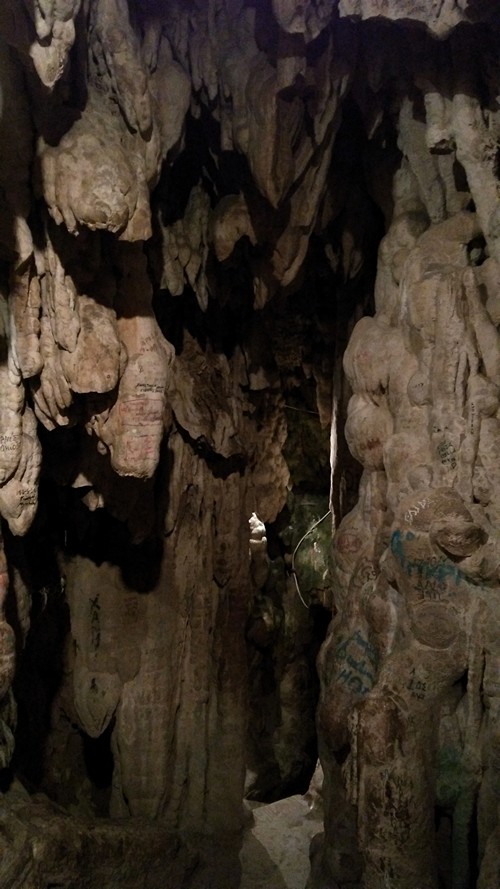

The cave is considered one of the rarest in Greece, as in it you can clearly understand how these very rocks were formed, from which the waterfalls fly. The waters of the river Edesseos itself, which flows through the city, and the waterfalls, come down from the springs formed from the melt waters of Kaimaktsalan. These waters are rich in salts and carry dissolved limestone, which settles at the edge of the rock and its surface, and thus the rock gradually grows and moves forward. Unlike other famous waterfalls in the world, such as Niagara, which do not build up, but destroy the surface of the earth.
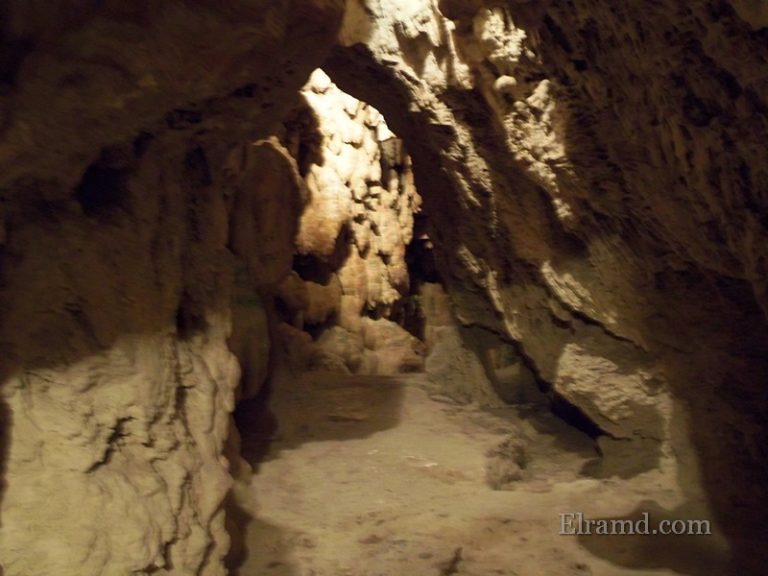
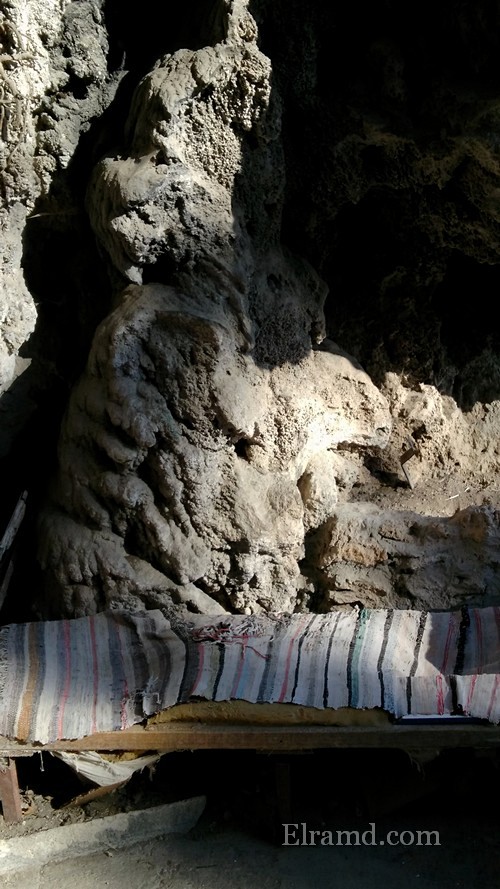
The most interesting thing, of course, is to walk along the stone fenced passage behind the waterfall, to look at it from the inside. We didn't go far, because we didn't want to get wet - it's not summer after all.
I can imagine how great it is here in the heat, when the spray of water gives a delightful coolness, and you can then warm up and dry in the sun!

You can go down the stairs to the very base of the waterfalls and admire them in full glory. In the evening, the waterfalls illuminate what must be a truly magical sight! We didn't have time to descend, maybe next time it will work out.
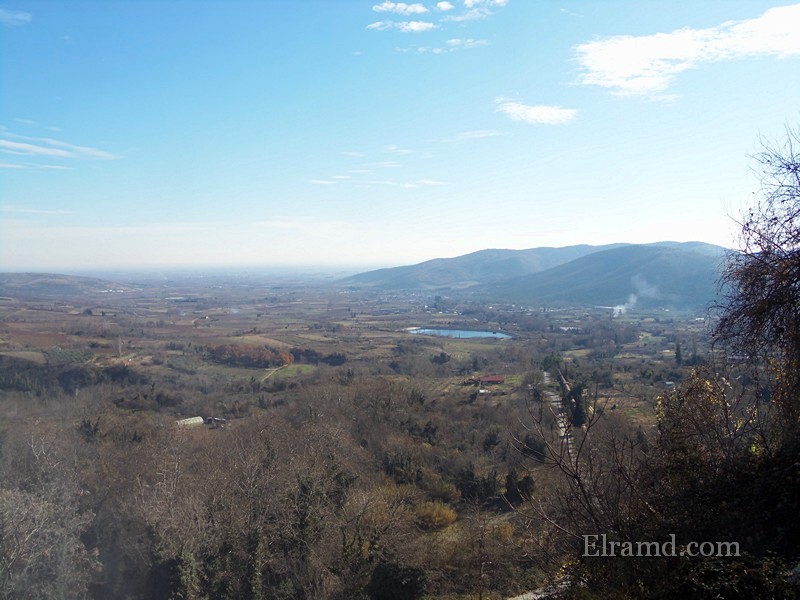
All this mass of water is completely controlled by DEI - the Greek electricity service. These streams allow two local hydroelectric power plants to operate, and are also collected on the plain into a lake that is used for irrigation of fields. And by the way, I read about a vivid example of the stupidity of officials: in the early 60s, this same DEI decided to build a new hydroelectric power station on the rock, and accordingly destroy the waterfalls. Residents of the city lay down with bones to prevent this outrageous outrage, and the decision was canceled.
In the video you can see and feel for yourself all the power of the water element:
The adjacent park is also very beautiful and picturesque.
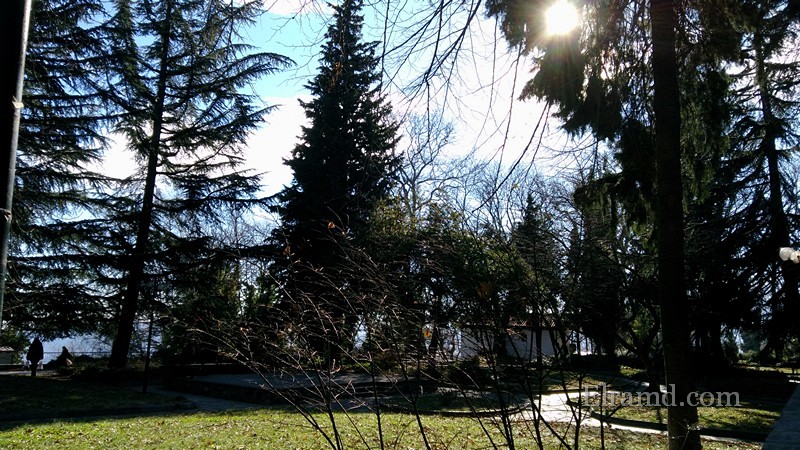
Unique century-old trees, one of which you can even hide in:


2-3 people can fit here

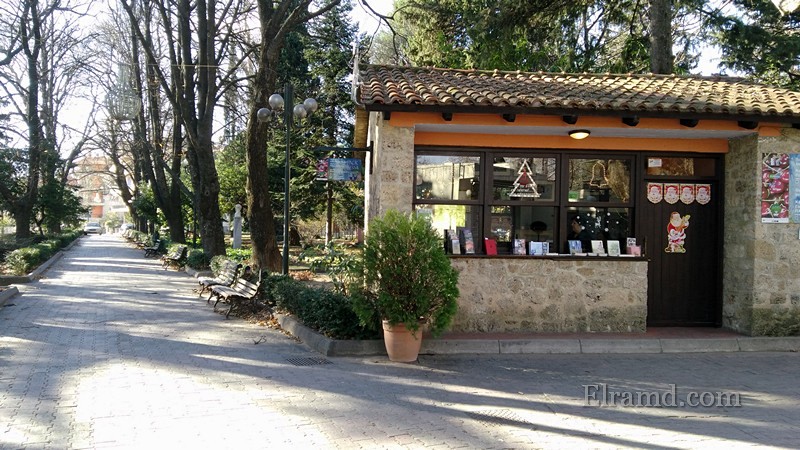
Small Temple of the Ascension of the Lord in the park:
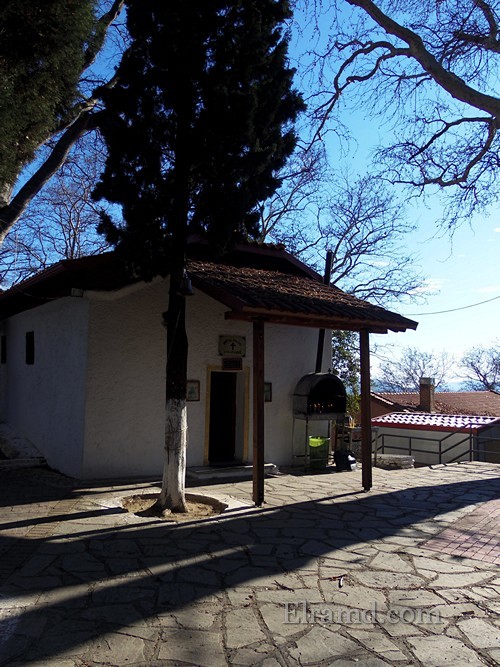

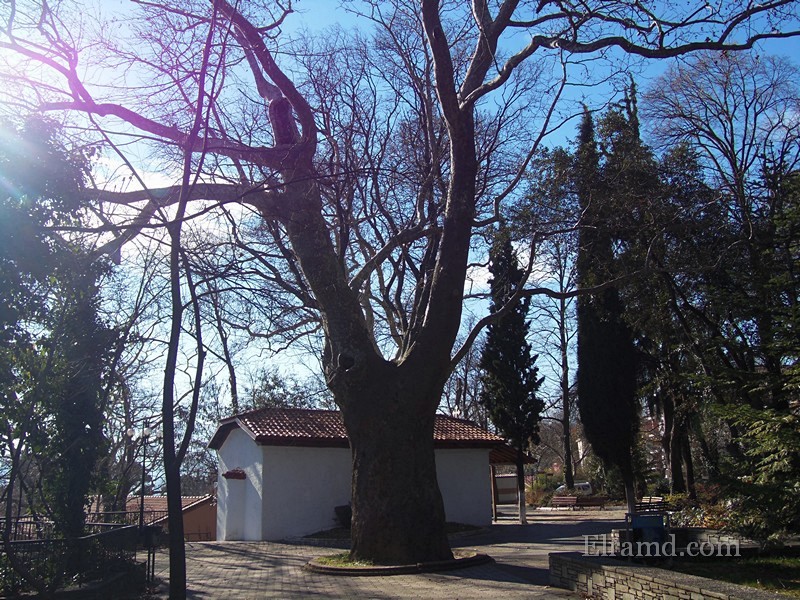
How to get to Edessa and the waterfalls
Of course, the most convenient way is to travel by car. From Thessaloniki it is about 90 kilometers, the road is quite decent.
On public transport you can also get to Edessa on your own. The schedule of regular buses from Thessaloniki and Athens can be viewed on the website http://www.ktelpellas.gr/, however, it is only in Greek.
In addition, you can get there by train. The schedule is available on the official website of the Greek Railways www.trainose.gr/.
See Edessa on the map
On the way to Edessa, you can also visit the archaeological museum and the ruins of ancient Pella. From Edessa you can also go to the thermal springs of Loutra Pozar, located only 32 km away. And for lovers of mountain air and skiing - climb to ski resort Kaimaktsalan!
The next day we began to build a more serious route for the journey. And here's what we got.
Route:
1. Metamorphosis(green dot) - Thessaloniki- on the E90 highway, past Veria, past Kozani, past Grevena - mountain serpentine - (blue dot).
2. Back: (blue dot) - serpentine mountain - E90 highway past Grevena, past Kozani - Veria - (blue dot).
3. And home: (blue dot) - Thessaloniki - Metamorphosis(green dot).
Purpose of the trip:
- See the rocks and monasteries of Meteora (and this is one of the main wonders of Greece)
- See the town of Edessa and the Kharanos waterfall in it
- And just ride around Greece
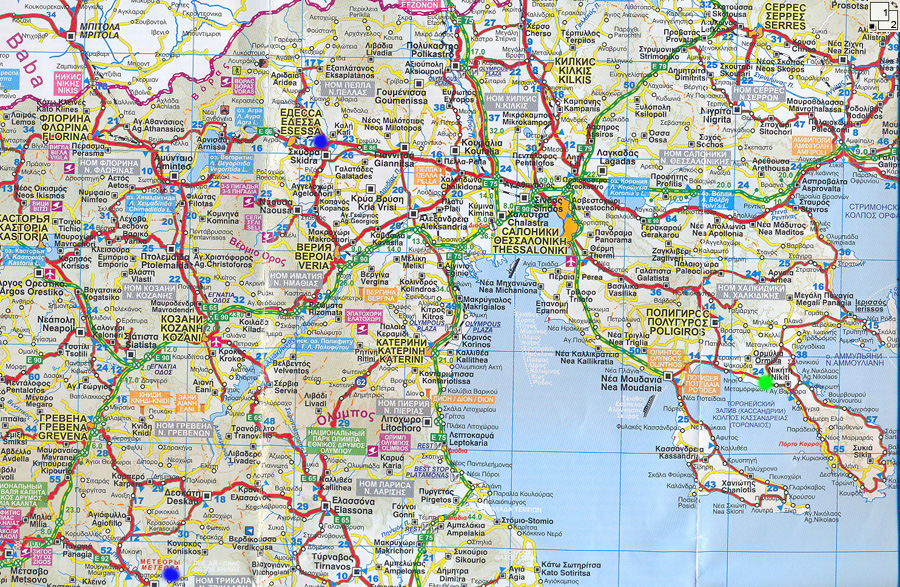
Click on the map - you will see the route we were driving.
From Thessaloniki to Meteora about 260 km, from Edessa to Thessaloniki about 80 km. Our entire route is about 750 km.
We left Metamorphosi at about 9 am, after breakfast at the hotel. We drove past Neo-Moudania, Thessaloniki along the ring road, drove onto the E90 highway. After leaving Thessaloniki, after a few kilometers, there is a fare payment point. You must pay 1.2 euros.
Veria remains to the right of the track:
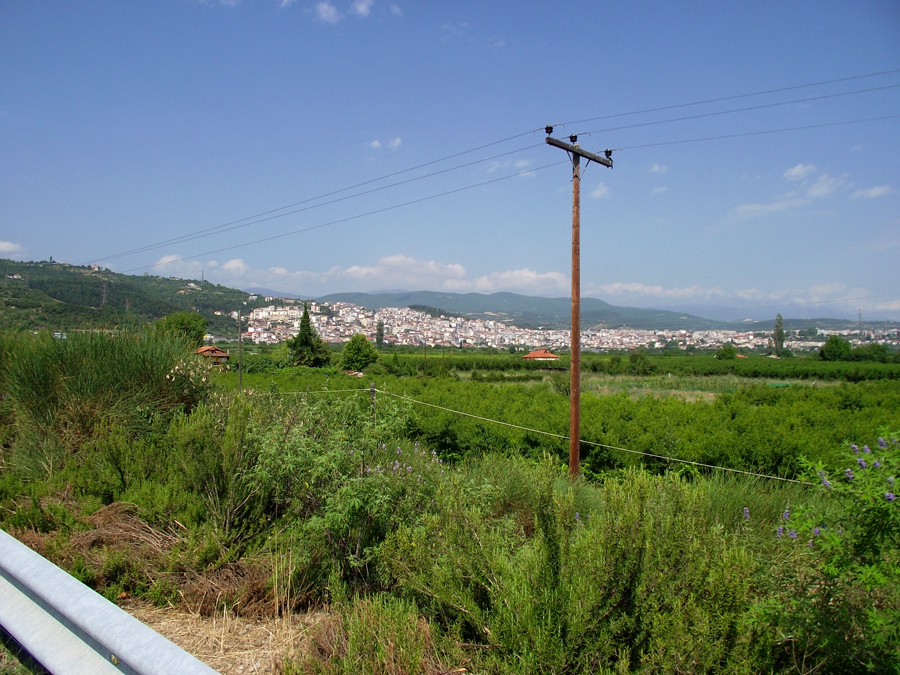
Immediately after Veria we find ourselves on a very boring section of the track. Judging by the altitude shown by the navigator, we are climbing quite high (I don’t remember exactly, but over 700 m above sea level). But the rise is smooth, without serpentines. But we pass one by one 14 tunnels (!). The length of the tunnels is different, from 200 m to 2.2 km.
* next picture and some others in the upper right corner are marked with . This means that under such a picture is hidden another one - similar or from a different angle. To display the second image, click on the first image; to return the first, click on the second.
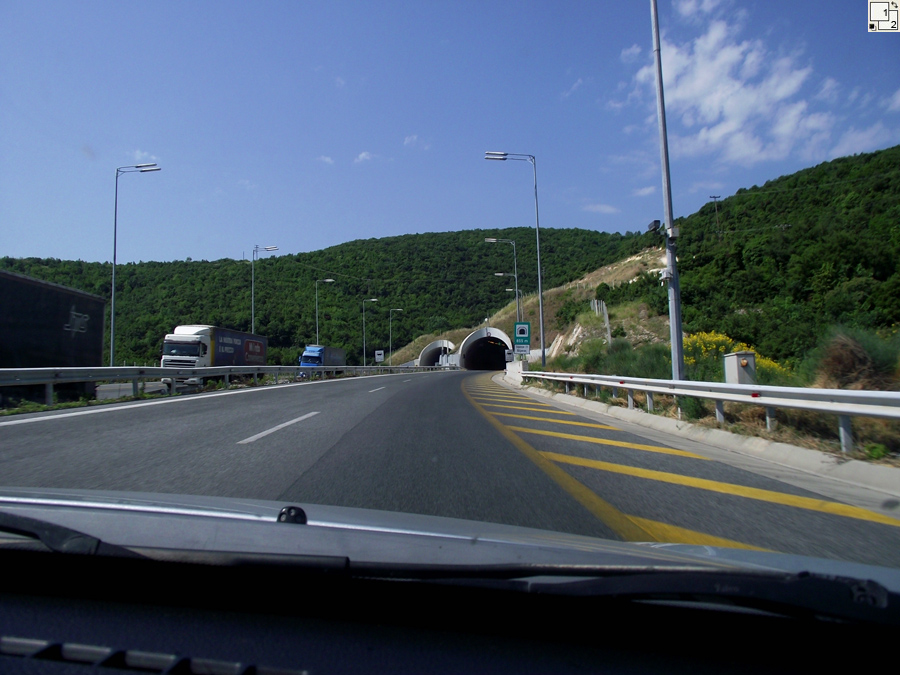
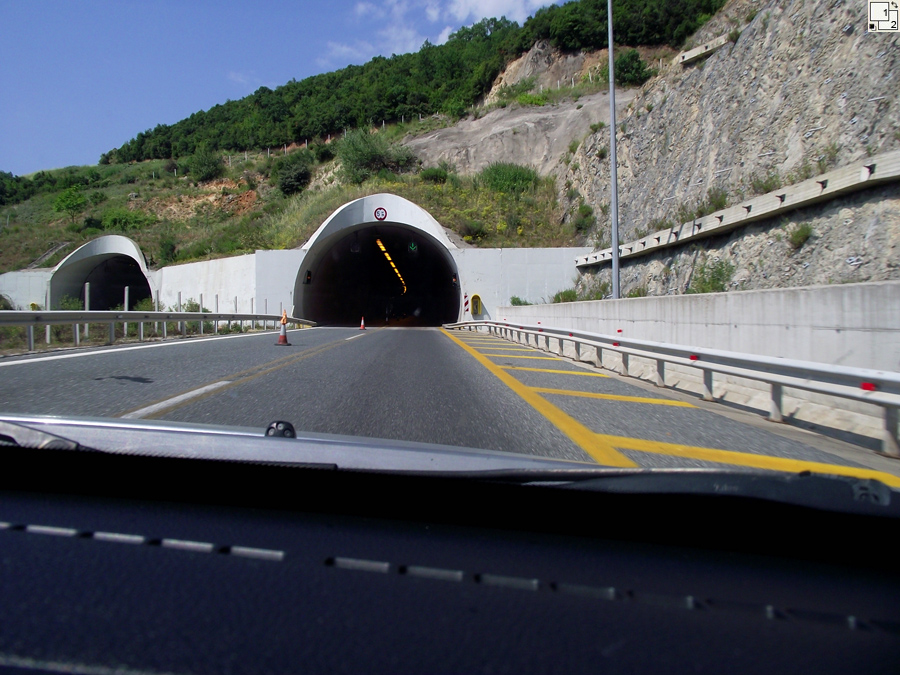
There are 2 lanes in the tunnel for you. The oncoming stream travels through its adjacent tunnel.
Inside the tunnels are well lit, through ventilation is provided (there are propellers under the ceiling that drive air through the tunnel), the speed is limited to 80 or 90 km / h
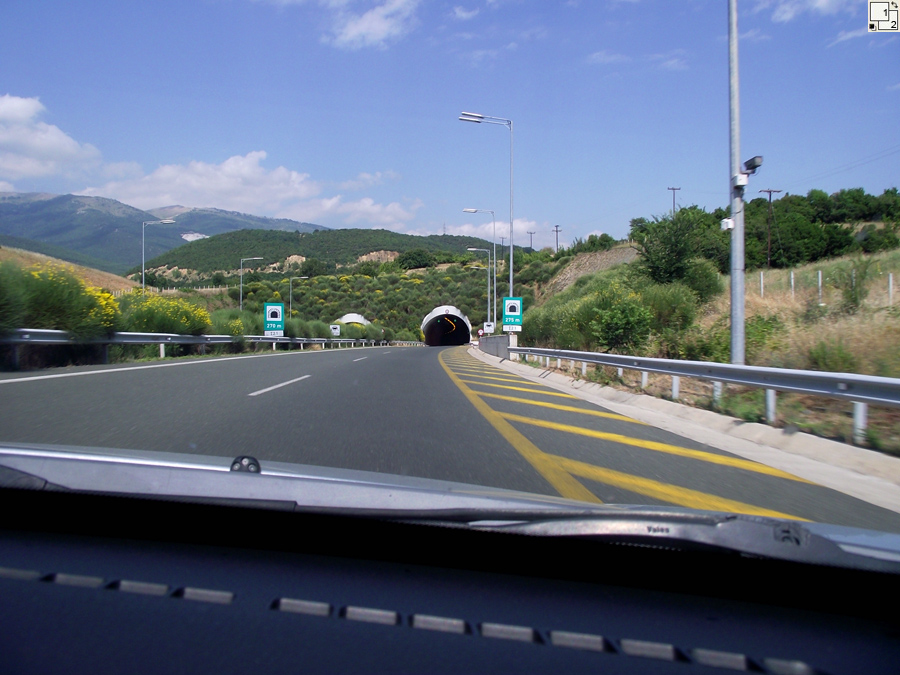
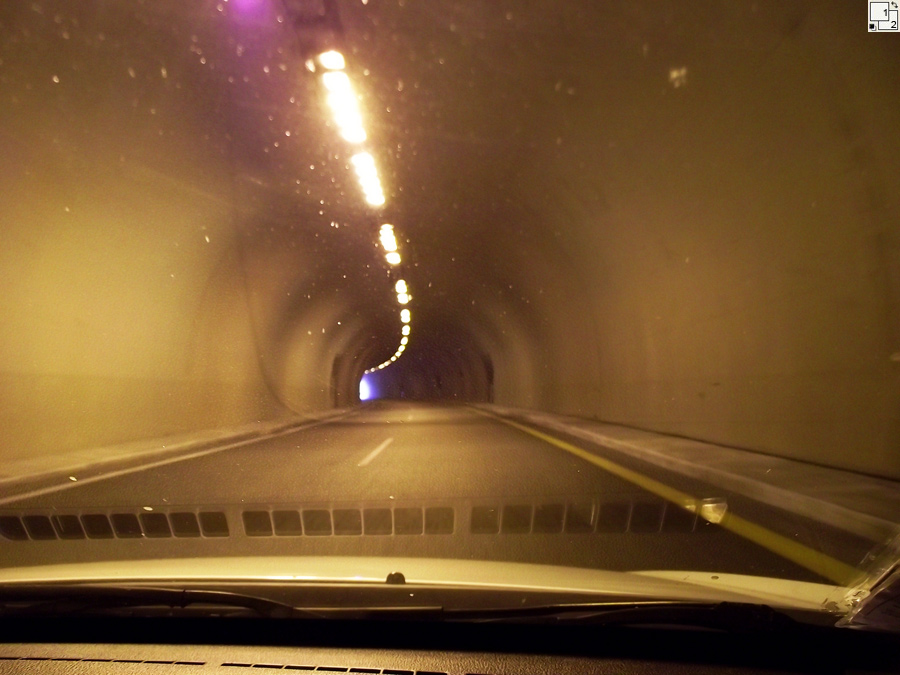
There are probably viaducts between the tunnels, but we can only guess about it, because the road is not visible from the side, but we are driving along it.
After passing the last tunnel, there will soon be another toll station - now it will be necessary to pay 2.4 euros. This is understandable - you have to take money for such a high-budget attraction with tunnels :). Payment points represent an extension of the road from three to approximately 8-10 lanes, in each lane there is a barrier and a ticket booth. It takes two or three minutes to pass the checkpoint, no more. The issued receipts for payment do not need to be saved - they are not needed by anyone.
Well, after payment we go further along the E90, keeping our way to Grevena, and there we will turn left.
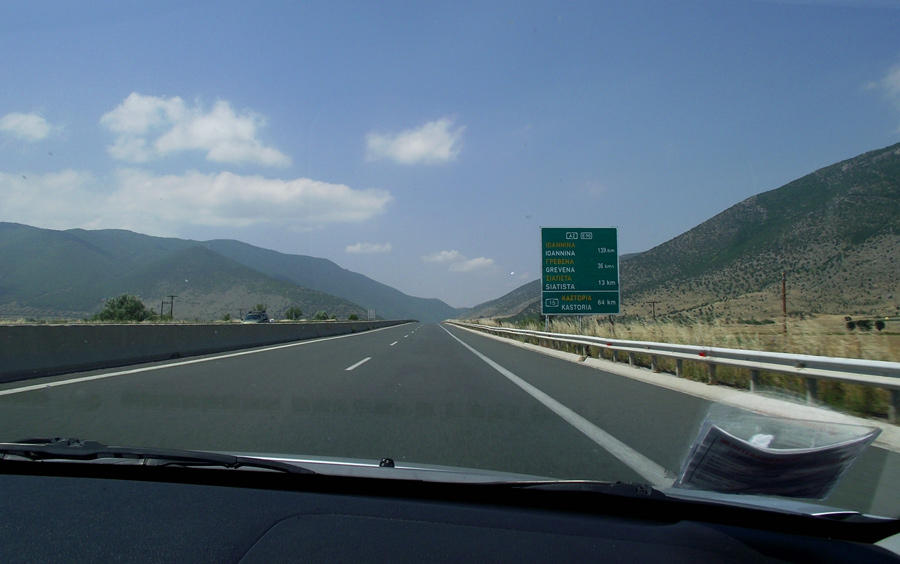
While Grevena is still 36 km away and nothing interesting is seen along the road, a few words about road traffic in Greece. The way we saw this movement, having traveled 1400 km in Greece in 4 days.
Traffic in Greece
Roads in Greece are of very decent quality. Green routes on the map (E90, E75, for example) are practically autobahns, 3-4 lanes in each direction, a bump stop in the middle, there are exit and acceleration lanes, the speed is limited to 120-130 km / h. These roads are toll, as I wrote above. Red roads on the map are also good - 1-2 lanes in each direction, excellent asphalt, 90 km / h limit. They are free.
The Greek car park as a whole in terms of the composition of models and the average age of cars is similar to ours, if we delete all Lada, Muscovites and Volga from ours. Only the share of diesel cars is very small, mostly all on gasoline. There are enough ten or fifteen-year-old cars in Thessaloniki, they do not stand out from the total mass. The locals are not fond of minor repairs. There are enough fresh cars on the roads with minor damages, scratches, the Greeks are in no hurry to bring them back to their original appearance. Scratches do not affect speed, fuel consumption does not increase - well, okay!
In the morning and in the afternoon (weekdays), the traffic is small, the movement itself begins in the evening and closer to the night. The Greeks sleep off in a siesta and by the evening they become active - there is very dense traffic on the roads, everyone rushes about 120 km / h, overtaking you, because you drive your legal 90-95 km / h. You feel pretty uncomfortable. The Greeks violate, but not aggressively. Most often they ignore the signs of the speed limit, the STOP sign, sometimes a double solid. At first I tried to stop before the STOP sign, and as a result I created an emergency several times. Drivers following behind were clearly not going to stop. Discouraged by my stop before the STOP sign, they were forced to brake to the floor, for which they expressed their censure and bewilderment to me with the screeching of horns. I had to comply, and soon I also learned to drive STOP without stopping, especially if other cars were watching me. Direction indicators are also perceived by Greek drivers as an optional device, they are used only occasionally. The request to free the leftmost lane to get ahead is expressed not by blinking, but by turning on the left direction indicator (Aha! That's what they were invented for!). Gratitude for the fact that the leftmost lane has given way to get ahead is expressed in no way by flashing the hazard warning lights - in this case, everyone will think that your car has broken down. Sometimes they give thanks with a sound signal, more often they don't give thanks at all. As a rule, pedestrians at unregulated pedestrian crossings are not allowed to pass, they stop if only a person has already taken a few steps along the carriageway. Crossing the road on a pedestrian crossing in Greece must be carefully. The fines in Greece are large (I don't know in detail, but even for an unfastened seat belt over 100 euros), so I do not recommend following the example of the natives and violating traffic rules. The traffic police were seen only 4 times during the whole time, it seems that the police are not particularly active. The accident was not seen, except for one thing - a small van drove into a ditch, everyone is alive, the injured driver will recover. The impression was that stupid accidents (when one did not keep his distance and drove in front of the one going in the backside) simply do not happen here. Boors and inadequacy on the roads we did not meet. Drive normally.
Oh, he started talking, almost missed the turn at Grevena! After this turn, we leave the green E90 expressway and enter the regular road:
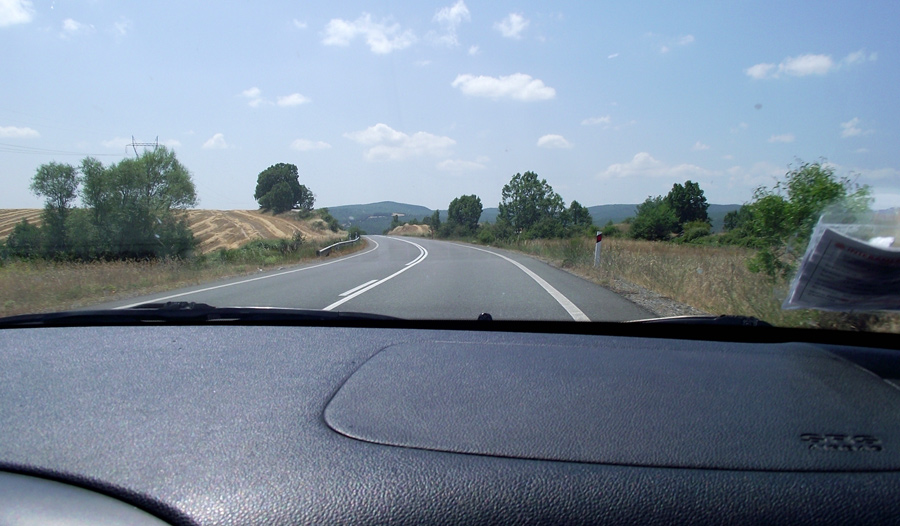
which very soon turns into a mountain serpentine, climbing up the mountains.
Having found a suitable site for the exit, we stop to stomp around, take a look around:
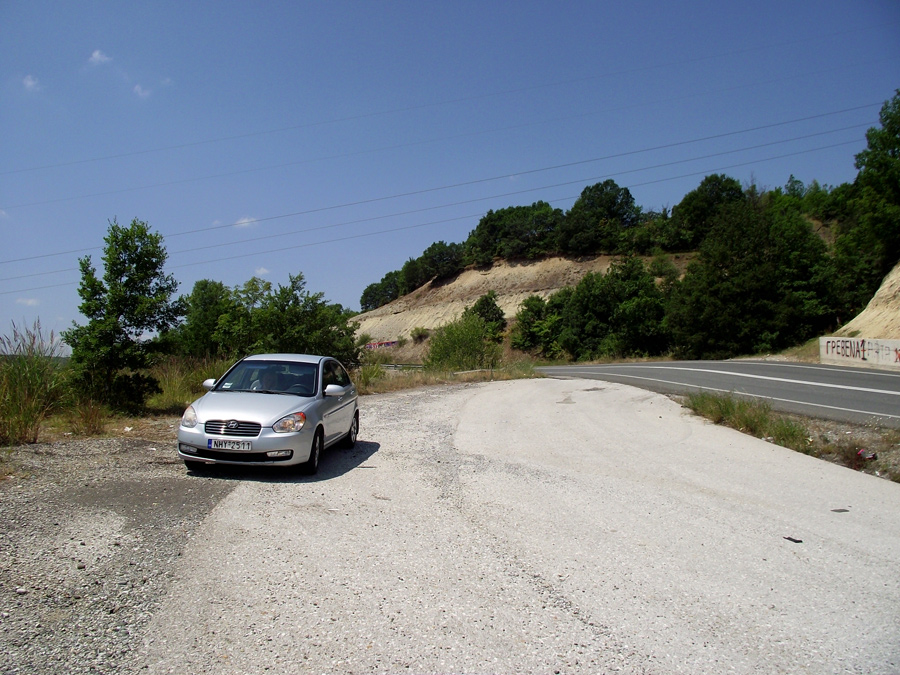
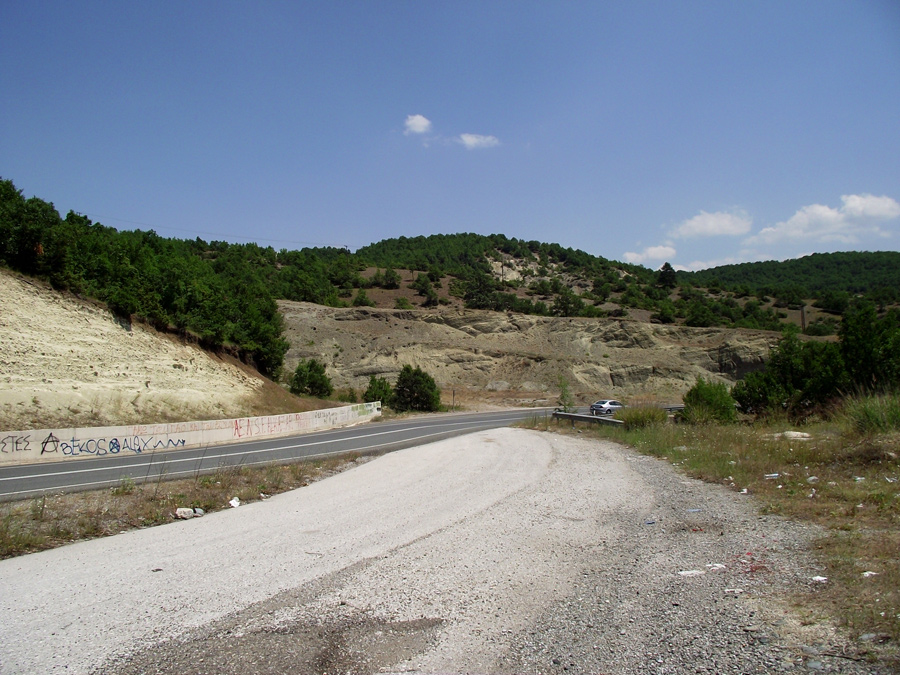
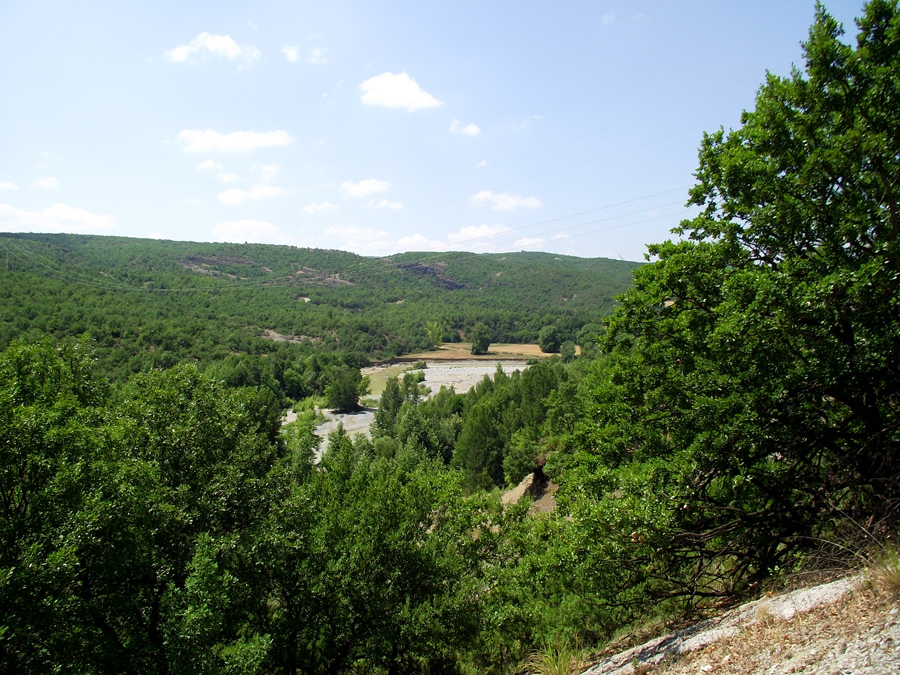
Nearby is a small chapel, of which there are a huge number on Greek roads:
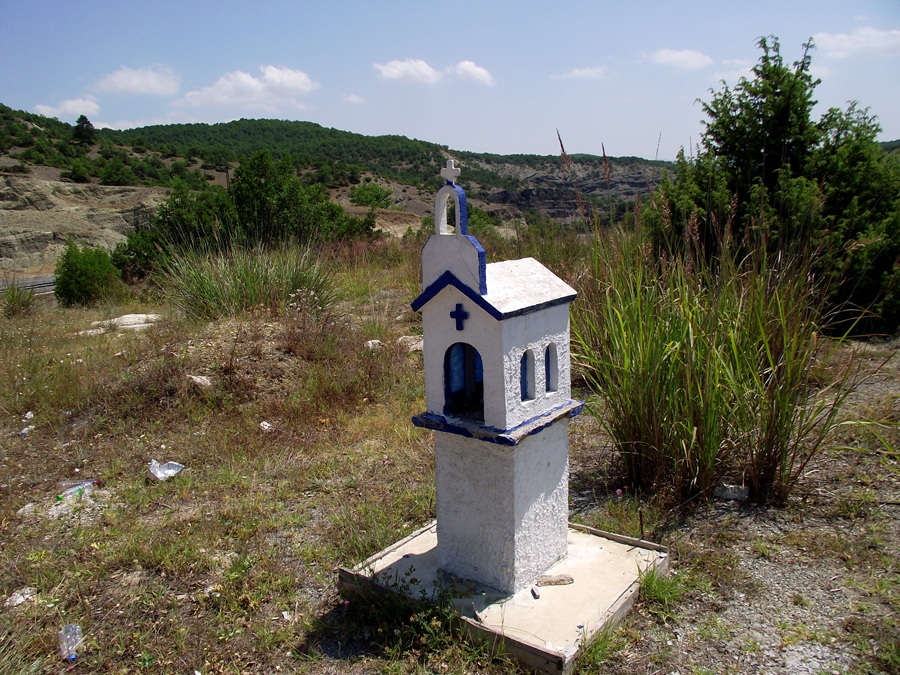
Serpentine now climbs up to a height of more than 1000 m above sea level. But it happens smoothly, there are two lanes everywhere on the road, excellent asphalt, there are no steep ascents and descents, there are no dangerous rolls of the car either. After the Caucasian or Crimean serpentines, here you feel very calm while driving. Passengers don't worry either :). The length of this serpentine is about 40 km.
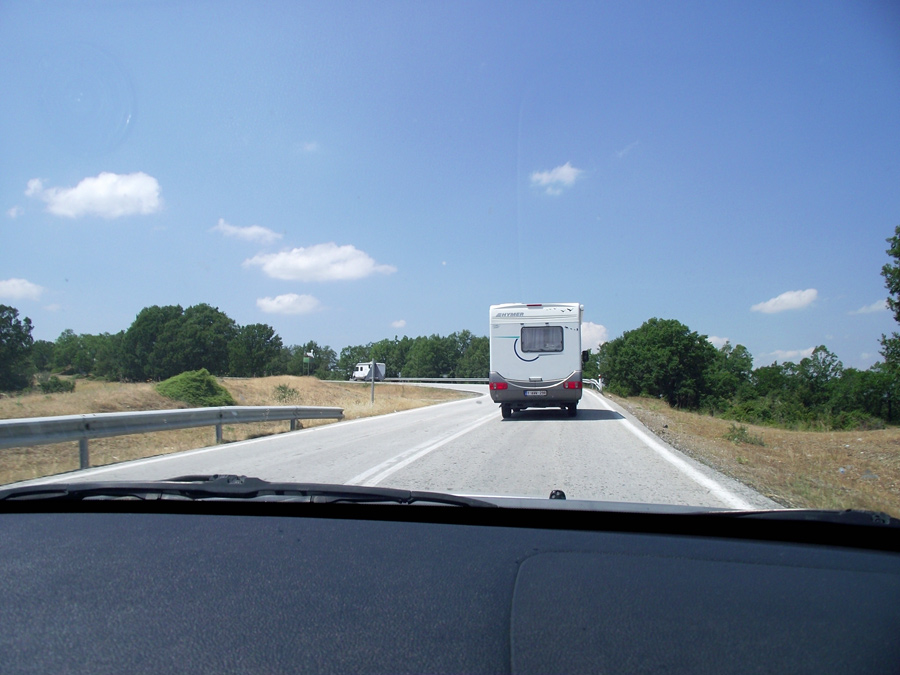
Having overcome the pass, we also gradually slide down to the plain.
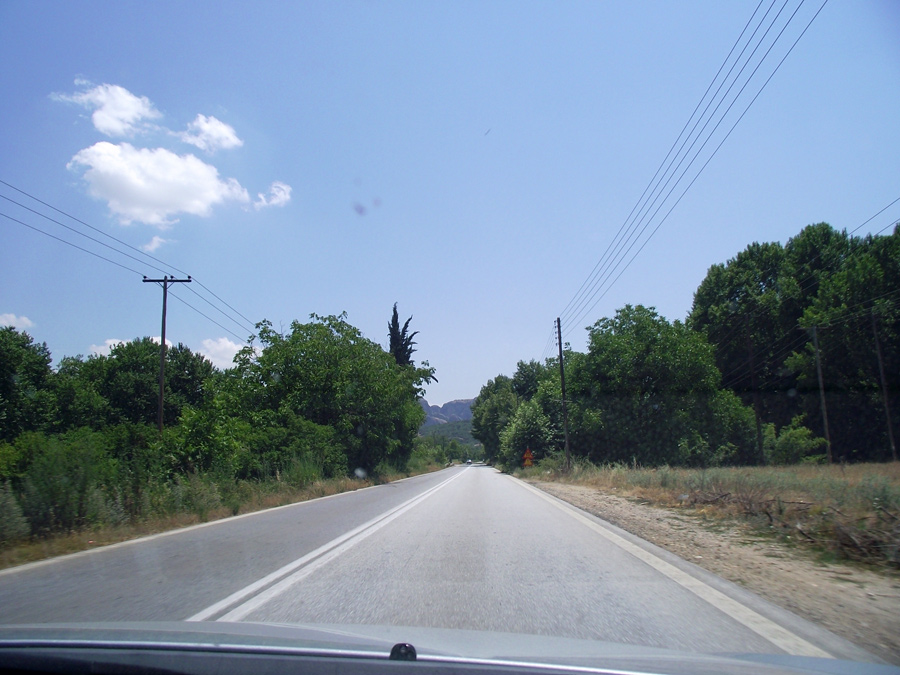
Soon, this road ran into another road, a larger one (the Trikala-Metsovo road), forming a T-shaped intersection. Turning on it to the left towards Trikala (there is a signpost), after driving a few kilometers, we saw what we were looking for: giant stone pillars-idols:
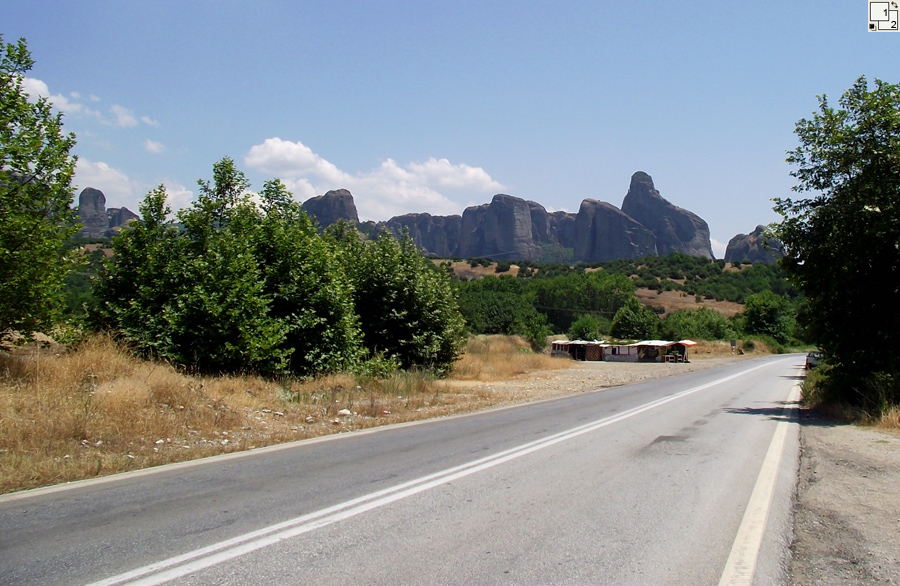

Meteors (or Meteora) are a geological phenomenon, their natural position paradoxically, and the origin is still really inexplicable. There is a version that the rocks are of volcanic origin, although there are no volcanoes nearby, and around the Thessalian plain.
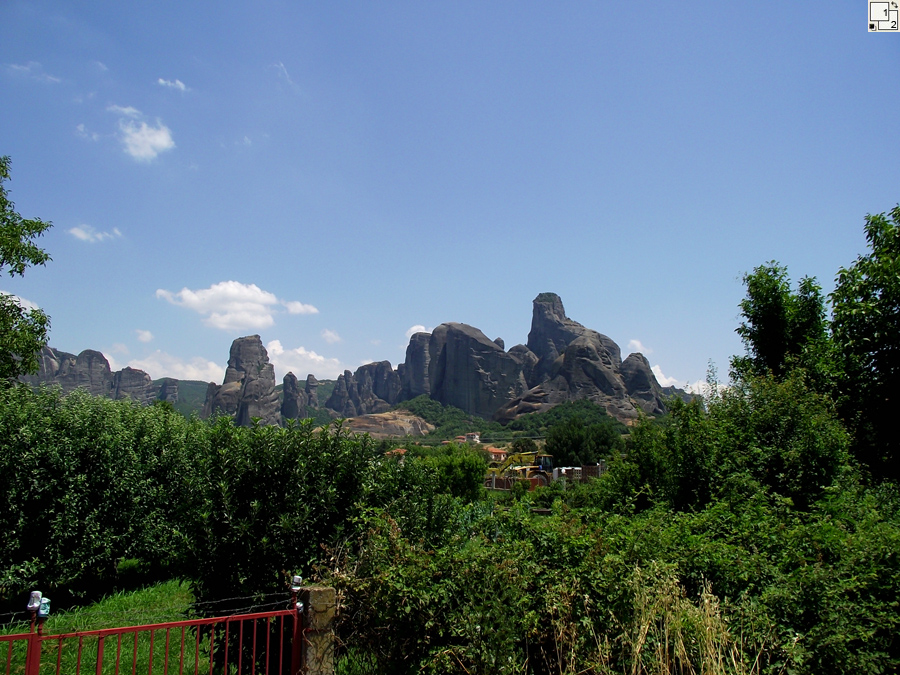
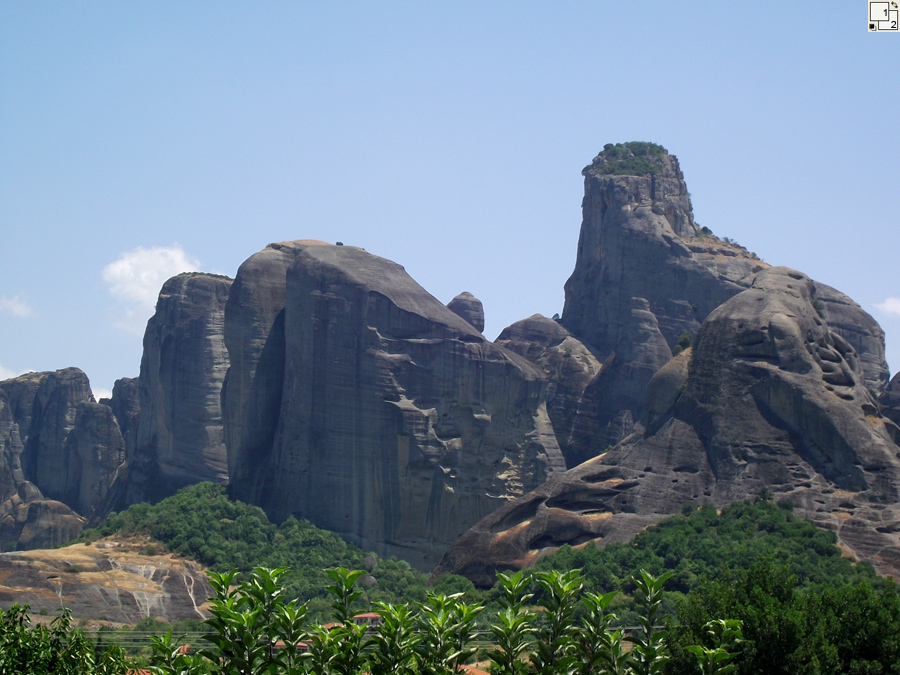
Having reached the small town of Colombaka (the starting point for viewing the meteor), they began to look for a place to park the car. You can't park your car everywhere, but finding the right place is easy. From any point in Kolombaki, these stone pillars are perfectly visible, at a glance:
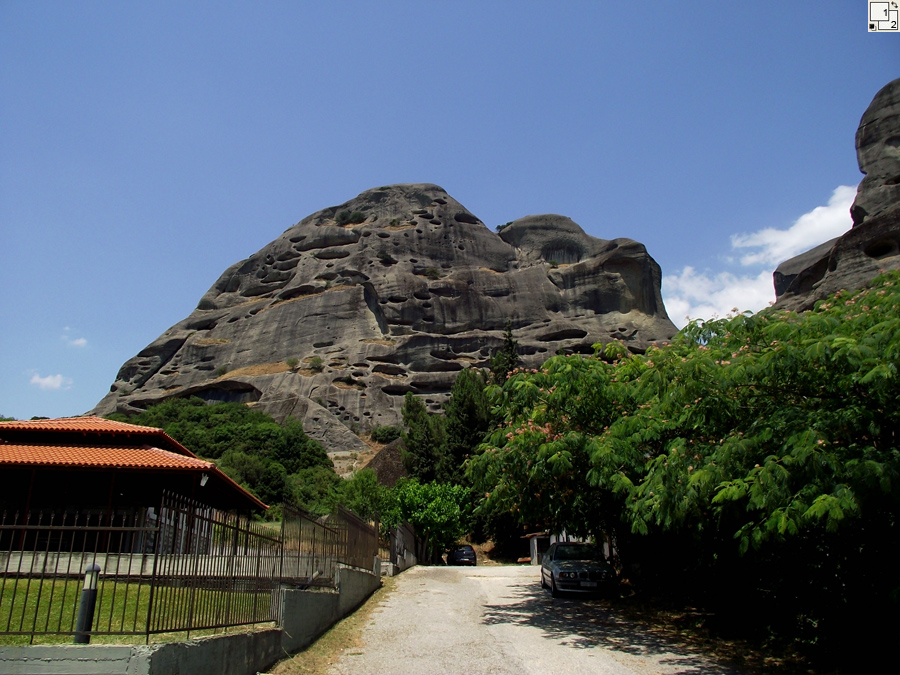

One gets the impression that these rocks-pillars are very close, just reach out to them - and you can touch them. However, we quickly figured out that their proximity is deceiving. Some confusion swept over us ... How to get close to them, how to touch them, climb at least one rock in order to look at one of the monasteries up close? We wandered for about 20 minutes along Kolombak, but did not understand where we still need to move in order to get close to the rocks. And then we saw the office of the excursion bureau. I went in and asked in English the manager who came out to meet me - how and where should we go? To which a clear answer was received that we still need to overcome 2 km, and the direction was shown by hand, they say, along this very street to the end, then to the left, and there is already one road. It was decided to return to the car, which was very reasonable. We drove about two kilometers along the indicated direction to the first monastery. The navigator, by the way, did not know Meteora as such, he knew only Kolombaka (and for this he thanks a lot, he brought us here perfectly).

Mysterious rocks are getting closer and closer ...
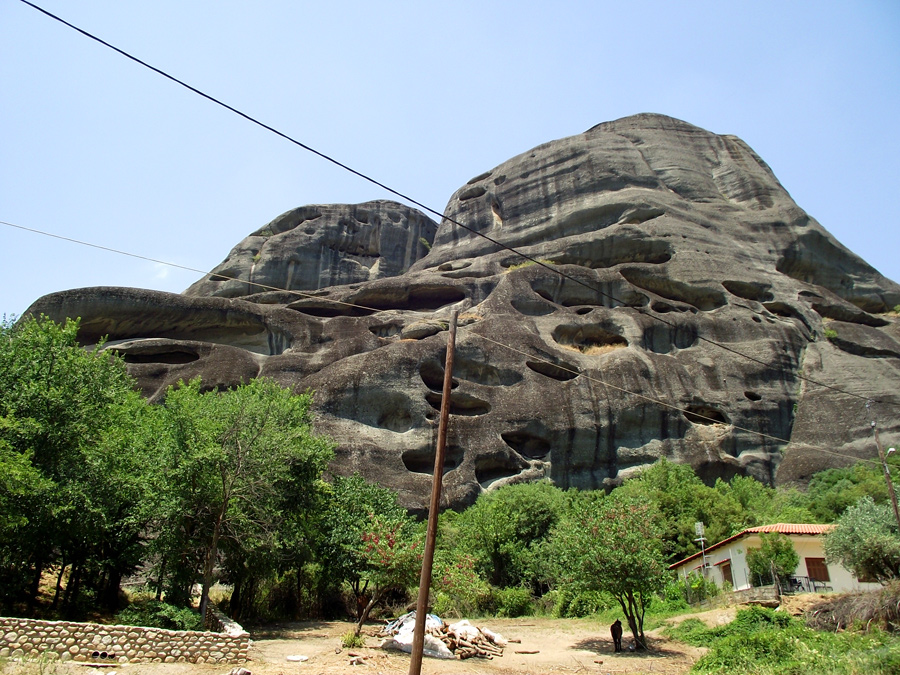
The holes in the rocks are not caves, but simply cavities that have formed from weathering.
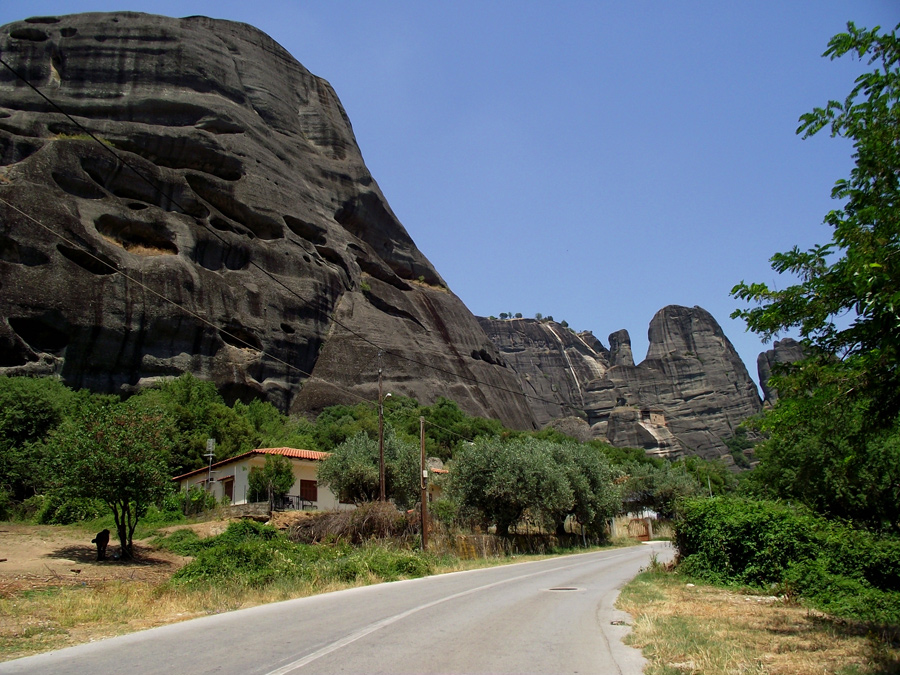
And after five minutes we drove up to the monastery of St. Nicholas Anapavsos:
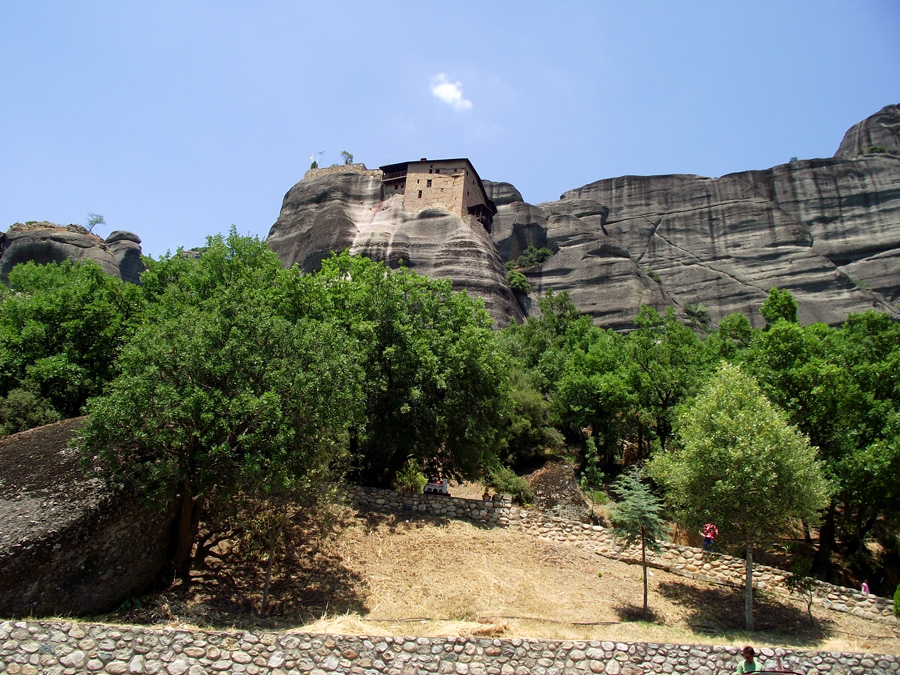


There are 6 monasteries in total, of which 4 are male and 2 are female. They have existed since the 14th century, and until the 20th century there were no stairs to the top. Everything needed was lifted with the help of ropes, and people also climbed up the ropes. Thus, the monks fenced off from the bustle of the world and felt closer to heaven, to God. At the beginning of the 20th century, by order of the local bishop, rock stairs were made, leading upward in zigzags. The bishop was unnerved by the ascent to the monasteries with the help of ropes and ropes. :)
Thanks to that bishop, we go up the usual stone stairs:

All monasteries have a dress code: a skirt is required for women, long trousers for adult men, it is unacceptable that the shoulders are open. However, if you are not dressed according to the norm, then at the entrance you can get the necessary change of clothes: skirts, scarves, long-sleeved shirts.
There are no monks inside this monastery, they live in the other five monasteries. This monastery is the smallest, most easily accessible. The entrance costs 3 euros. Filming is prohibited inside. But you can shoot into the distance from observation deck from the roof level of the monastery:

The rocks look absolutely inaccessible, even for climbers with modern equipment, they are considered very difficult to climb. The idea to equip a monastery complex here came to Saint Athanasius, who with two other monks arrived here from Mount Athos in 1336. According to legend, eagles carried Saint Athanasius to the rocks.
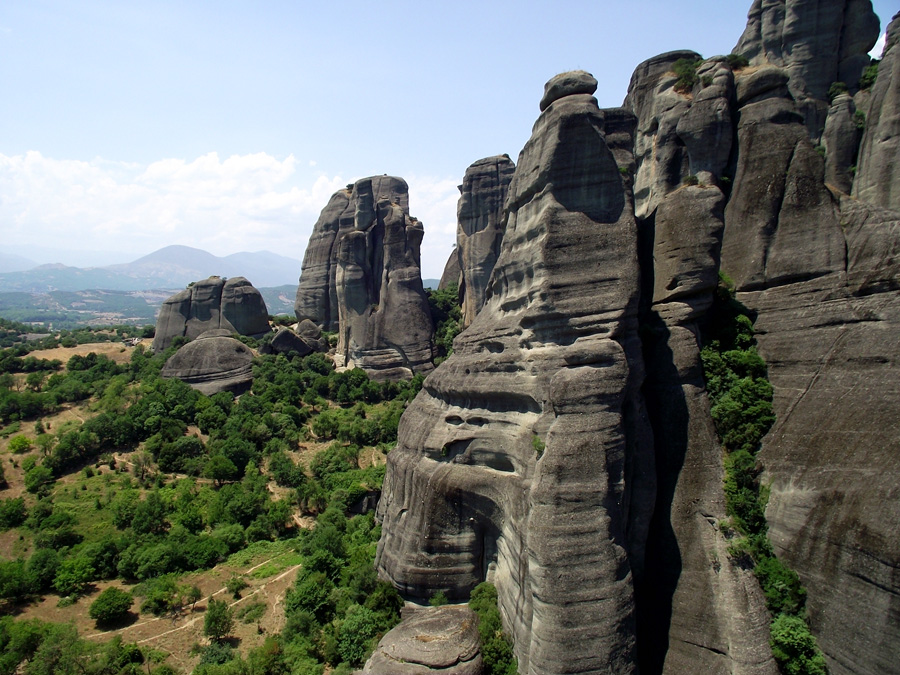

The neighboring monastery is visible:


We went downstairs. We did not go to other monasteries, limiting ourselves to a "car tour" (that is, looking at them from below from the car window):


Here, it seems, "climbing the ropes" still works, at least for water and electricity:
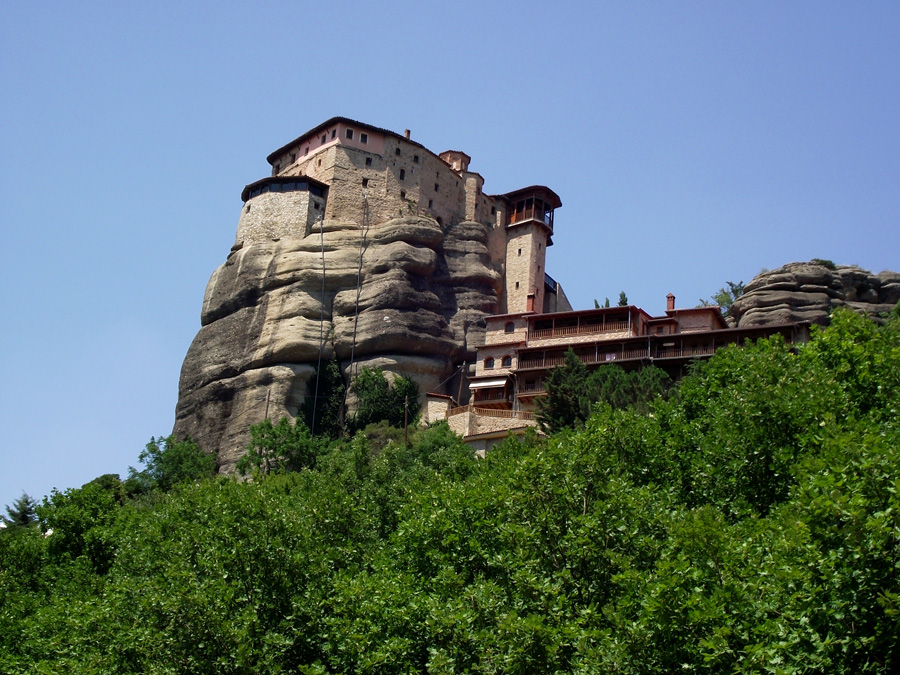
We looked at the monasteries and went to Kolombaku for lunch. Siesta practically did not leave a choice, I had to dine in the center of Kolombaki, trampled by tourists. Expensive. Lunch for our family came out at 50 euros with a tip, but at the same time tasty and satisfying.
If you want to independently explore all 6 monasteries in detail, then you will need two days. In this case, the best and easiest way is to stay in Colombac - this town is exactly what tourists live in. From Kolombaki to the nearest monastery Meteor about 2 km. If you find yourself in Colombac without a car (arrived by bus), you can hire a taxi to Meteora (it will cost 30-40 euros), the taxi driver can often act as a guide. Or you can walk on foot - just a dozen kilometers to walk.
It looks like this:
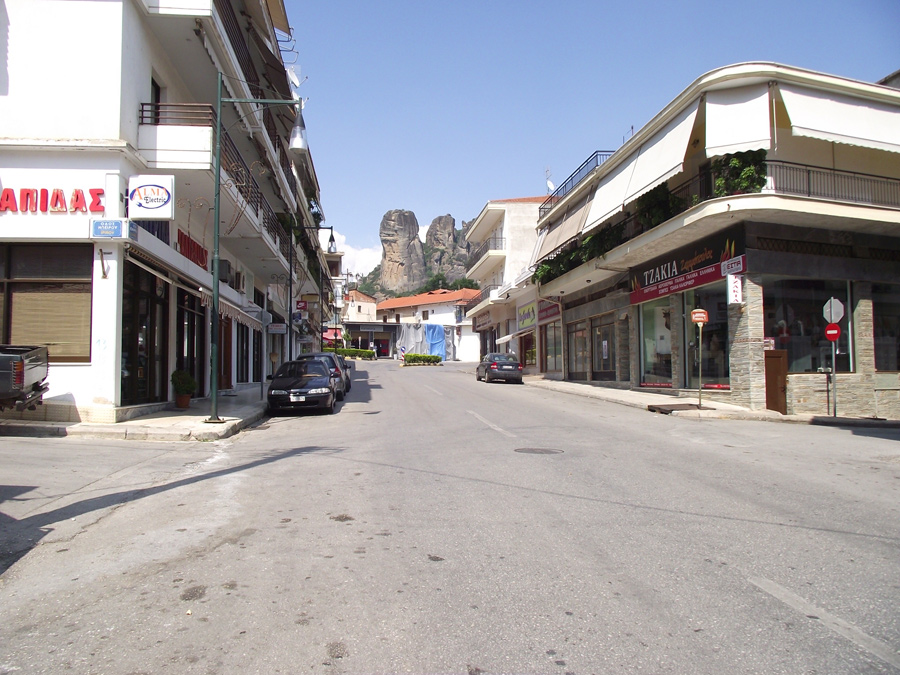
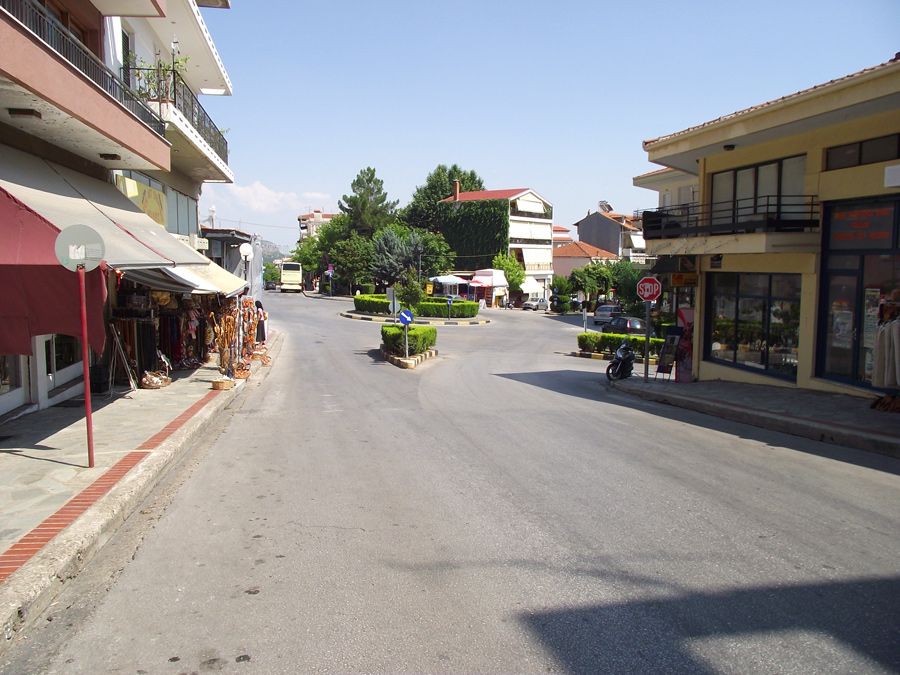
After dinner, we drove back. On the way back, we planned to visit Edessa to see the waterfalls and the town itself.
We go again along the same 40-kilometer serpentine, only in the opposite direction, with technical stops (our youngest son is still sick on the serpentines):
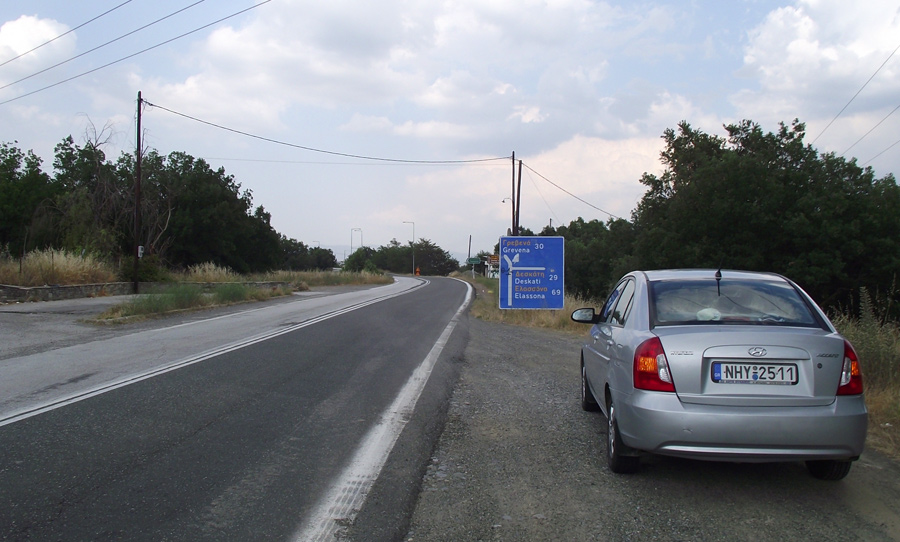
At Grevena, they again began to use the E90, accelerated a little - here 130 km / h is allowed. After passing a series of tunnels, we turned to Veria, where the usual (quite slow) road went to Edessa. However, the navigator brought it out without difficulty.
– tourist town Greece, located in Central Macedonia with a population of about 25 thousand people.
The main attractions of Edessa are the picturesque rivers, waterfalls (of which the most spectacular waterfall is Kharanos) and the water museum. Due to the large number of rivers and streams during the settlement of the city by the Slavs (VI - VIII centuries), it had the name Vodena (from the Slavic "water"). Modern name city is translated from the Phrygian language as "city on the water".
The navigator took us to the center of Edessa. Following the signs to the waterfull and the direction indicated by passers-by, we buried ourselves in a stormy river, fenced with fences. It became clear that we were at the goal, we can park, this stream will lead us to Kharanos. We parked the car and went for a walk along the river:
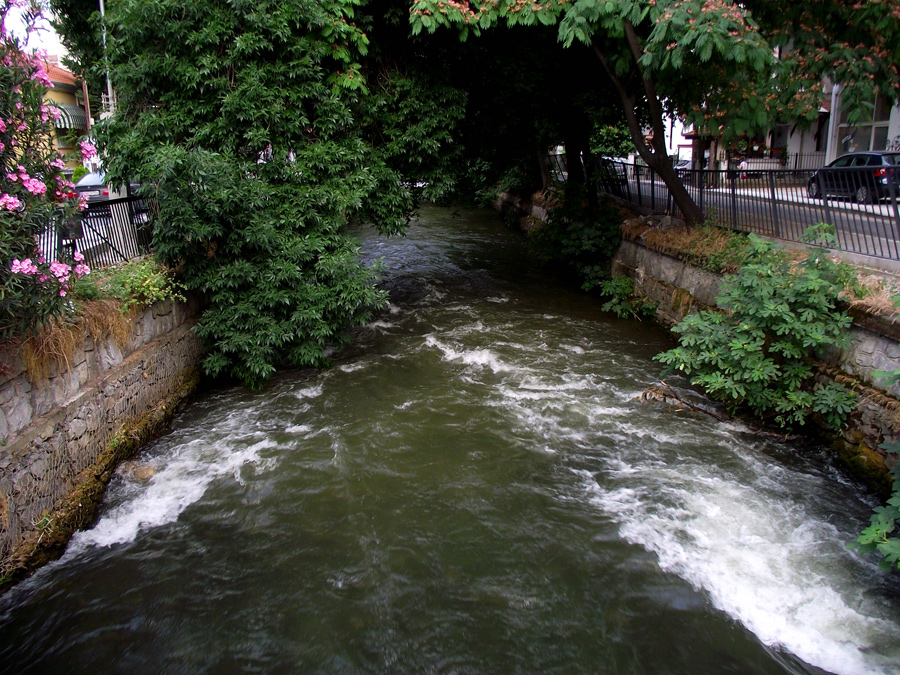
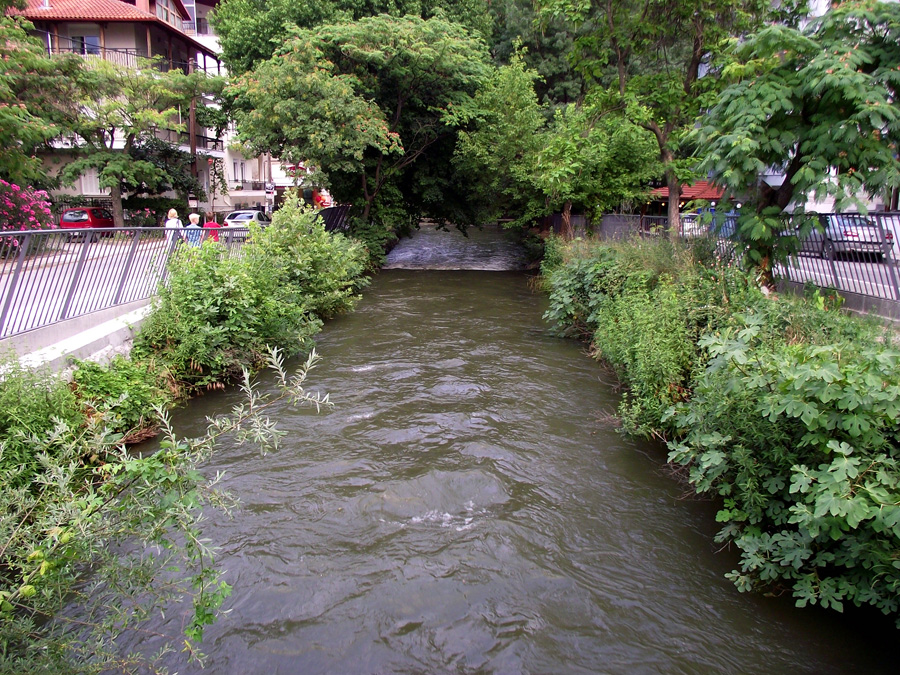
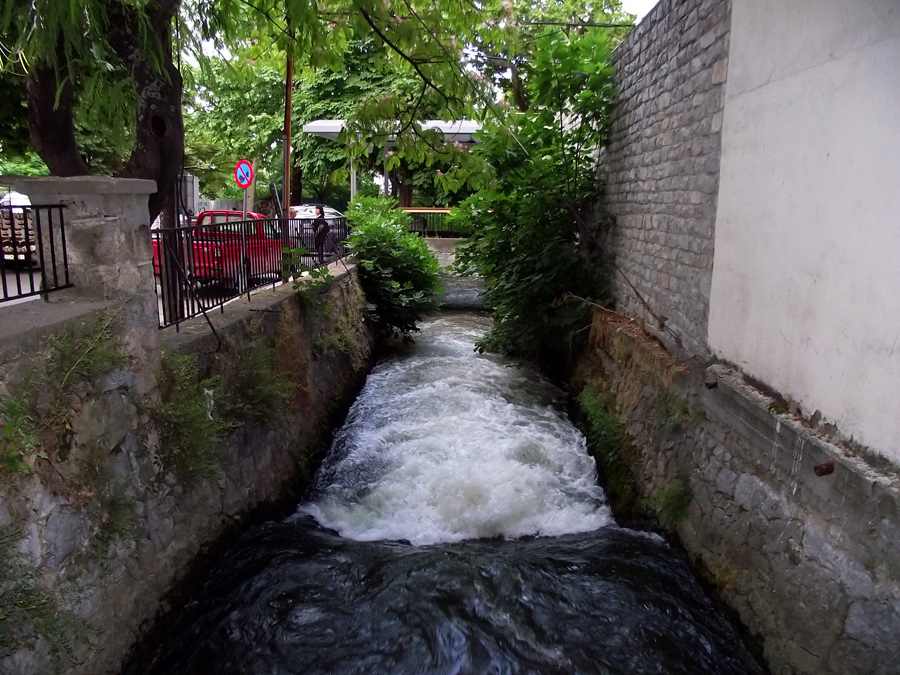
This river has a really fast flow. The video will help to estimate the speed of the current:
After a hundred meters, the stream falls down with several waterfalls, the highest of which is Kharanos(24 m):
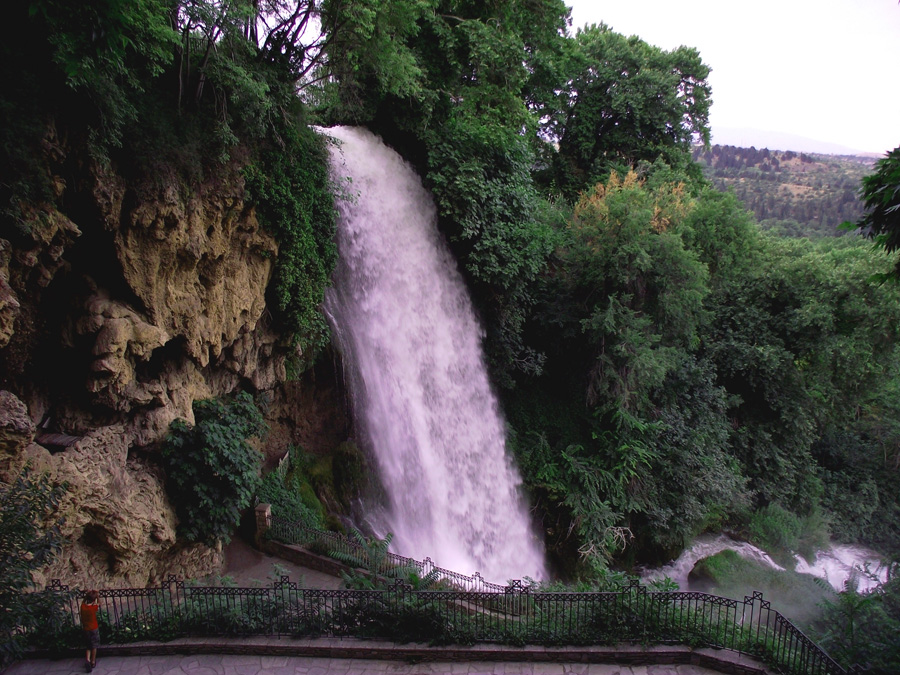

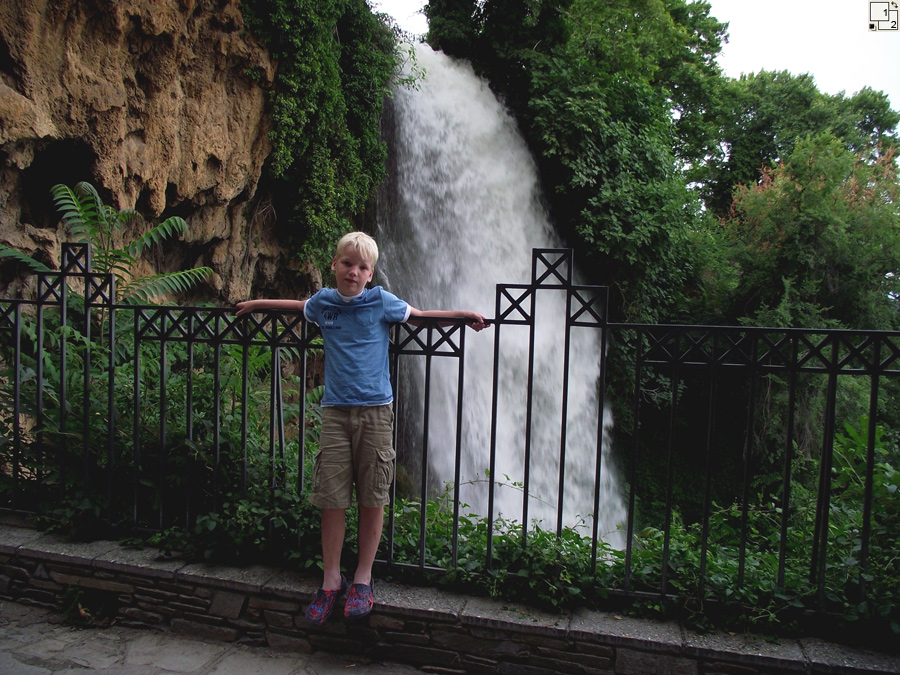

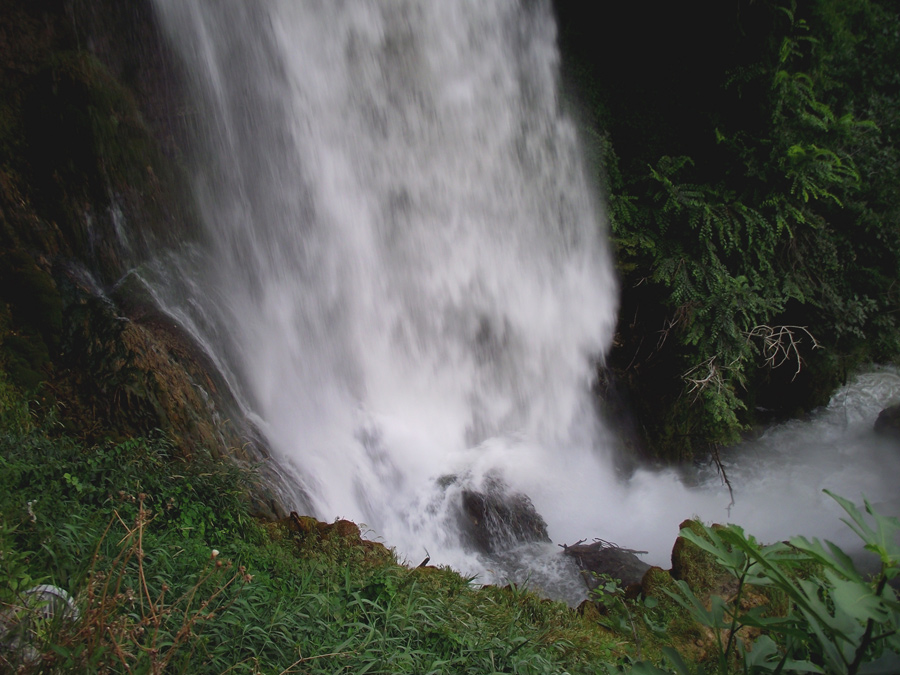
You can walk behind the waterfall, however, the terrace runs into a dead end:

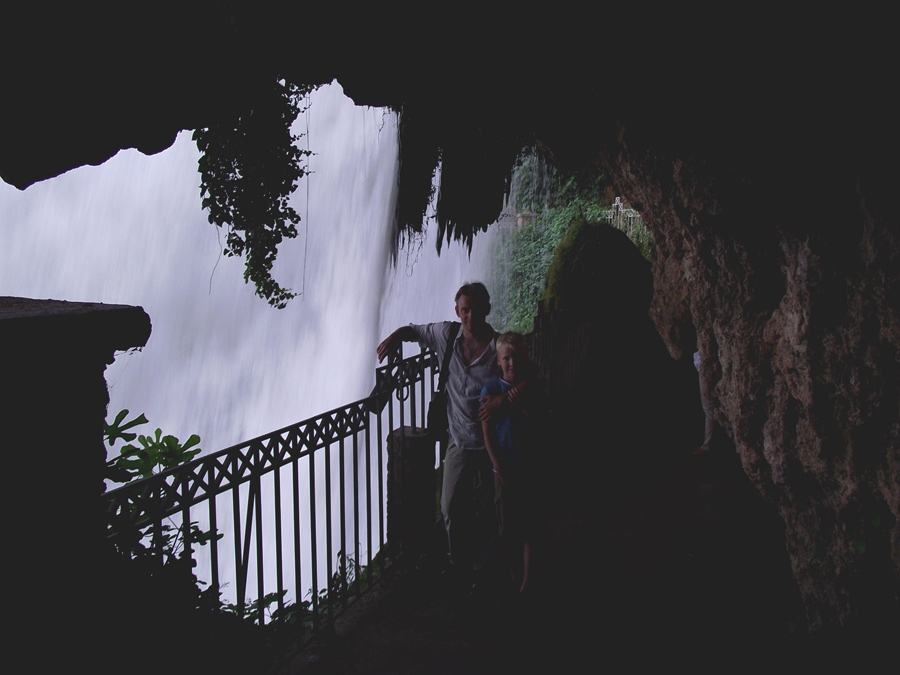
Video of Kharanos waterfall:
GPS coordinates waterfall in Edessa: N 40 ° 48 "01", E 22 ° 03 "01"
Edessa Water Museum demonstrates how you can develop abandoned production facilities on a tourist basis:

The work of almost all local factories and mills used to be based on the power of waterfalls. At the beginning of the 20th century, so many factories functioned in Edessa that the city was named Balkan Manchester.

Edessa leaves a pleasant impression, I would walk and walk along these streets.


But it's already nine in the evening, it's time to go home. We bought a magnet with Kharanos, ate some ice cream, got into the car and put the navigator on Metamorphosis - you can return to the hotel. The navigator shows that the hotel is 189 km away. After midnight, driving through the night Thessaloniki, we return to Metamorphosis.
June 26, 2013
Practical information
How to get (drive) to Meteora?
This aspect is described at the beginning of the review, where the map is. GPS coordinates of Meteora monasteries: N39 ° 42.488 "E021 ° 37.191"
How do I rent a car in Greece?
There are many rental offices in Thessaloniki - from world brands (Hertz) to various small ones. How larger city, the more rental offices, the lower the prices. In Metamorphosis, where we were based, there were only two rental offices - Space and Laki. Prices are about the same, but when renting a car, Space provided full insurance (no deductible) - we chose it. Pay attention to whether there is a deductible for insurance - it is usually 300-500 euros. Let me explain with an example. Let the deductible be 500 euros. In the event of an insured event, if the damage is less than 500 euros, you will pay for it. If the damage is more than 500 euros, then you only pay 500 euros. For us personally, it was important that there was no franchise at all - the head for the car does not hurt. Those. in this case, you will only pay for the punctured wheels.
In the case of renting a car with a franchise, you will have to leave the amount of this very franchise as a deposit at the rental office (if you pay with a card, then the amount of the franchise will be blocked on the card with your obligatory consent). In the case of full insurance, you do not leave anything as a deposit at the rental office, and when you return the car, no one will even inspect it. We rented the car in the following way - drove the car to our hotel, called the office (and it was already night) reminding us that we took the car for 4 days, today these 4 days expire, and we want to return it without delay. Despite the late hour, I was politely listened to and offered the following option - "leave the key on the left front wheel, and do not think about anything, go to bed and come to us again" :). This is a conversation, this is a service! - I thought. The key to the wheel ... And so he did. The next morning I woke up - the car was gone, as I understood, the distributors had taken it back at night.
Space provided a variety of vehicles and different insurance options. If the client wants full insurance, then by regular price car rental per day added another 5 euros. For example, that Hyundai Accent, on which we traveled in Greece, with incomplete insurance cost 49 euros per day, with full insurance - 54 euros per day. Those. for 4 days they paid 216 euros. Rent without mileage - in some offices there is a mileage limit, exceeding which you then pay extra, check this point. Other cars - Toyota Yaris came out 5 euros cheaper, Ford Focus was 7 euros more expensive. There are jeeps and business class - but there are about 140-150 euros per day. All cars are fresh, up to 5 years old. The cheapest car is Daewoo Matiz - 35-40 euros per day. But it is not recommended to take a very small car - it may simply not be able to master a steep hill or serpentine.
Car rental price depends on many factors:
- from car class
- from a gearbox - more expensive with an automatic machine
- from the number of rental days - more than 5 days - cheaper
- from the month of the year - July and August - hot season - highest prices
- from the insurance option (no deductible - more expensive)
- from where you are. In Athens or Thessaloniki, all other things being equal, it will be cheaper than in the resort periphery
When you receive the car, do not be too lazy to check the presence of a jack and a spare wheel. First aid kits, by the way, are not provided in Greece. In the office you will have to hand out a lease agreement, a registration certificate and insurance (we had insurance glued to the windshield).
Under the terms of the lease, you will have to return the car with the same amount of fuel (not less) than when you took it. Cars are usually equipped with an onboard computer, which shows how many kilometers there is still gasoline left. If, when you took the car, the on-board computer showed a power reserve of 200 km, then when returning the power reserve should be at least 200 km - otherwise you will pay extra for gasoline.
There is also a second option - you took it with a full tank of fuel, and you give it back with a full tank of fuel.
What is required to conclude a car rental agreement in Greece?
- international law, at least 2 years of experience
- your current location - the name of the hotel, room number - will also be entered into the lease agreement.
- desire to travel by car :)
Refueling and fuel prices in Greece
We poured gasoline into our Hyndai Accent in the 95th (it is called Normal there), the price varies from 1.63 to 1.74 euros. We saw diesel fuel - about 1.33 euros per liter. Advice from personal experience- see a gas station - refuel! Gas stations are very unevenly scattered along the highways - sometimes dense, sometimes empty. When a gas station is needed desperately, it may not be within tens of kilometers. As we had - there was 80 km of gasoline left in the onboard computer, they missed one gas station (the price of gas seemed a couple of cents higher than in Metamorphosis), so then the next gas station was found only after 45 km, and then away from the highway. We were worried then ... And it is also useful to know that many gas stations do not work at night, during siesta, and in the dark.
Enjoy your travels in Greece!
All about Greece:
Greece
Has made an invaluable contribution to European culture. Literature, architecture, philosophy, history, other sciences, the system of statehood, laws, art and myths of ancient Greece laid the foundation for modern European civilization. Greek gods known all over the world.
